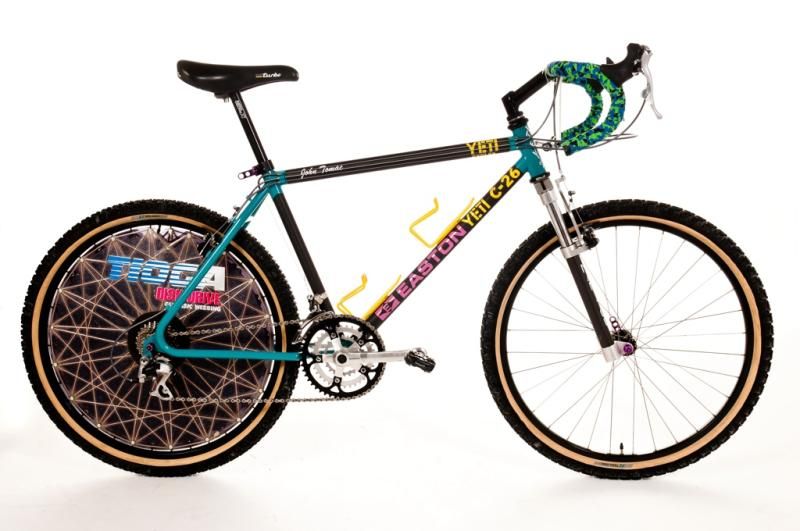
ridevintagemtb
Monday, July 15, 2019
Soft Spot for Stumpjumpers
I have a soft spot for early 90's Stumpjumpers. Whereas when pushed, some frames with classic steep geometry (*cough* Wicked Fat Chances) want to wander out from underneath me, the Stumpjumper stays cool under pressure. I owned the carbon version of this bike and it performed amazingly. Since I'm a sucker for basket cases, pulling this one from the trash was a no-brainer and will no doubt be a satisfying restore and rider.


Thursday, February 12, 2015
Juli Furtado in 1991
1991 was Juli's first full year on Yeti. She was world champion
having only been racing mountain bikes for a half season and road bikes
for a year prior. She raced an aluminum ARC almost exclusively and had
numerous versions of the frame. Here is a photo retrospective of that
year examining the bike details.
This is a french magazine article featuring Juli's bike. This is a very early ARC and notable for the fact it has a FRO-like one-piece rear end. I've never seen a single other ARC frame like this. Other key frame details include the enclosed top tube cable stops, black Yeti decals, and black Furtado decal. Specialized Ground Controls which she would drop soon for Onza Porcs.
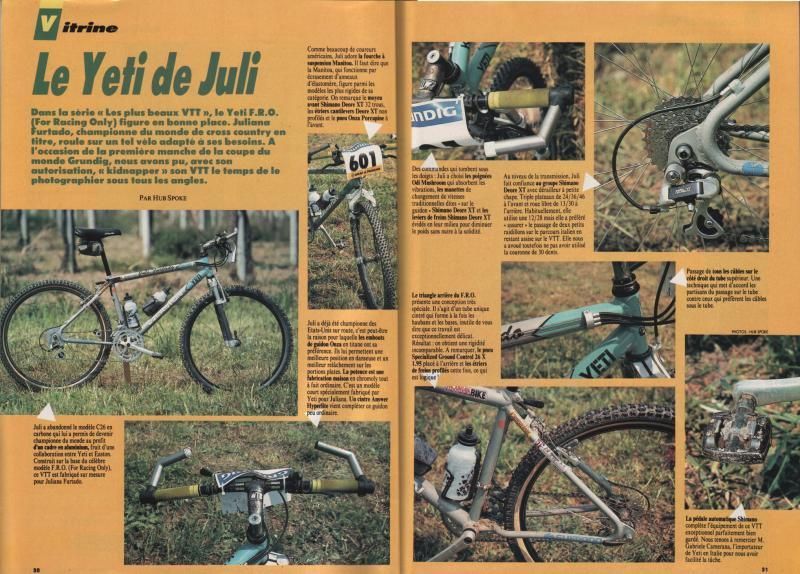
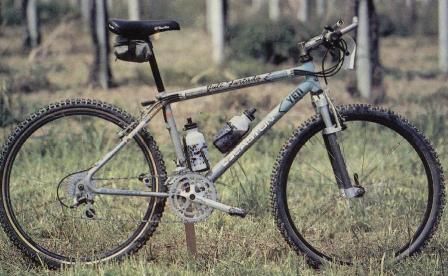
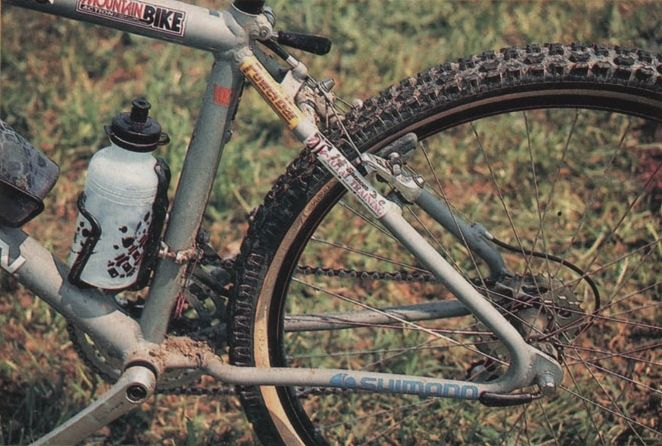
First race photo from the season. She's in world champion stripes, a jersey she would seldom wear during the year. Juli wore four jerseys that year: Standard Yeti, NORBA series leader, Grundig World Cup leader jersey, and World Champion. Juli says the day's jersey decision was made for her, which I always found odd. But it illustrates her loyalty to her sponsor. Here she's in her WC stripes. Looks to be same bike from the french mag. Doug Bradbury Manitou (pre-Answer) fork. Drops the thumbshifters as well for Rapidfire M092? units.
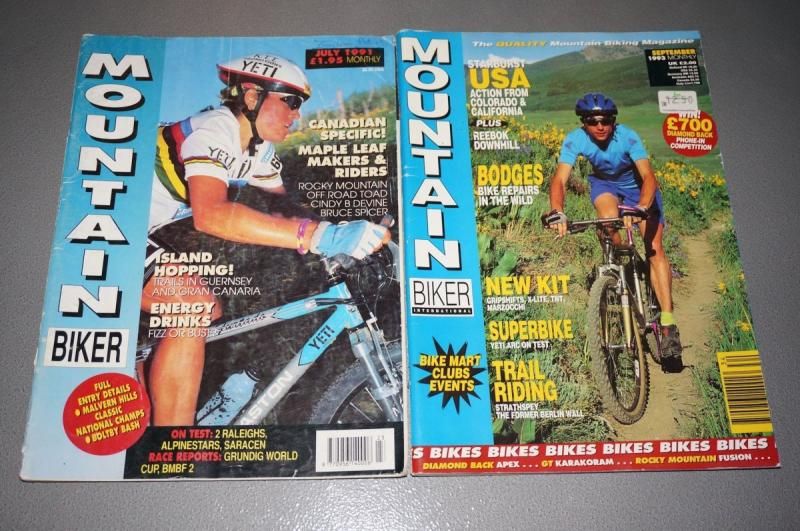
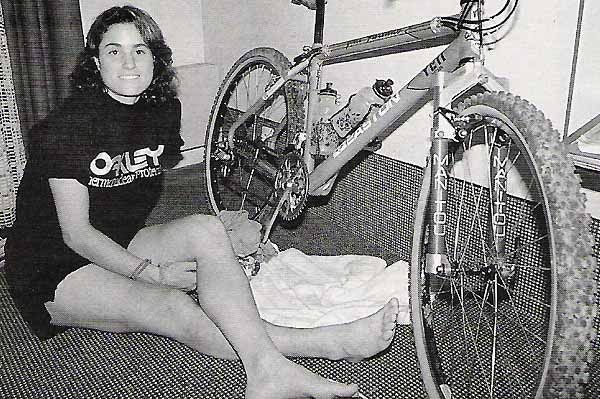
Big Bear, likely May 1991. No obvious changes to the bike. Decal placement suggest she's still race the early bike with the FRO-like rear end. The Onza ad also shows a loop near the bottom bracket which supports this.
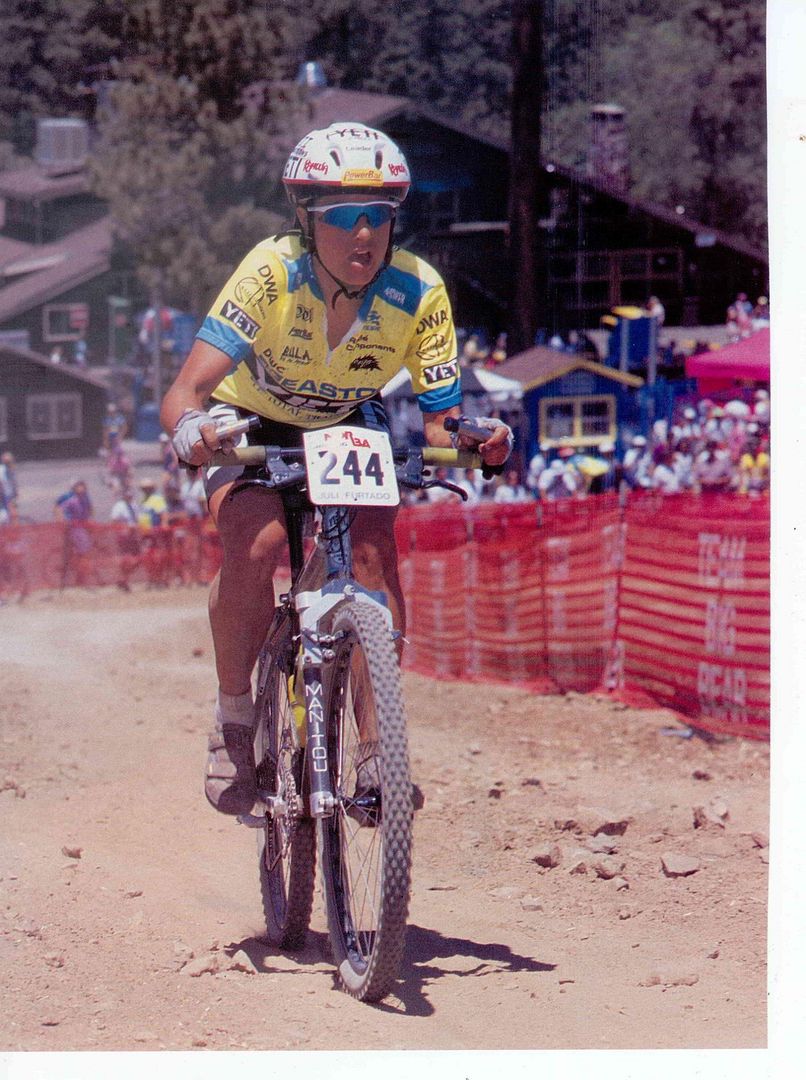
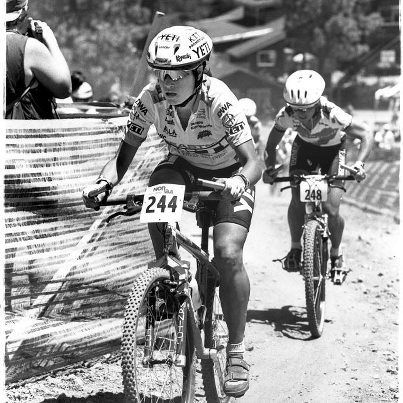

This is one worth taking a second look at. Who is this ad for, Onza or Panaracer? There are two different, competing products from two differing companies being promoted in the same ad? What's also interesting is that this is clearly Big Bear and at this race she had Onza decals on her bar ends, yet these decals seem photoshopped out (years before that was possible).
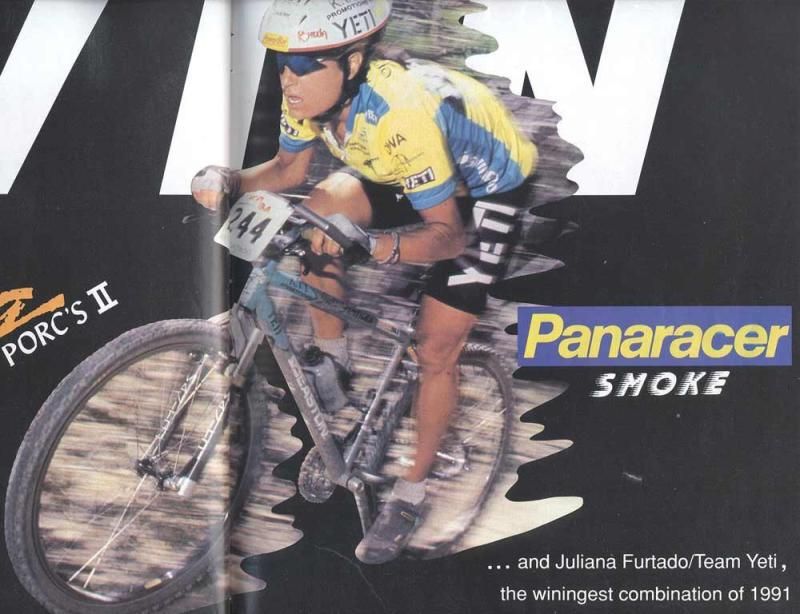
Iron Horse Bicycle Classic, Memorial Day, May 1991. First we see of a bike change, and some key component changes as well. Frame has white Yeti decals and cleaner cable stops. Gone (temporarily) is the steel FTW stem for what looks to be a team-cut Answer ATAC. One would think this would be a perfect race to showcase the World Champion jersey, but nope.
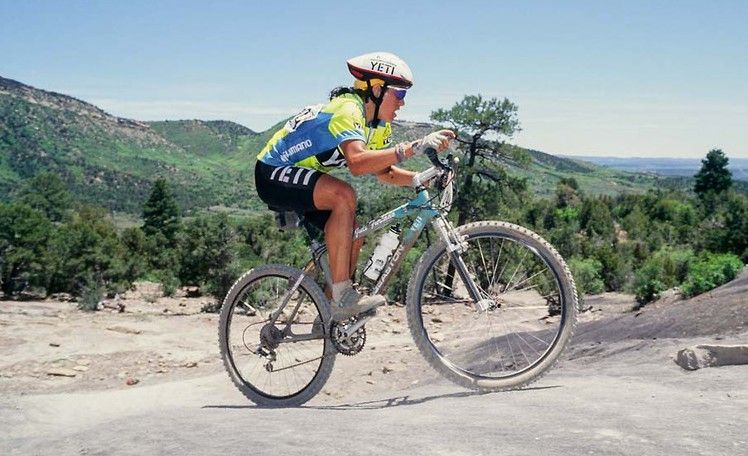
An unknown World Cup race. Looks like bike #2 with a steel Yeti stem back on. Early race since she doesn't have the leader's jersey.
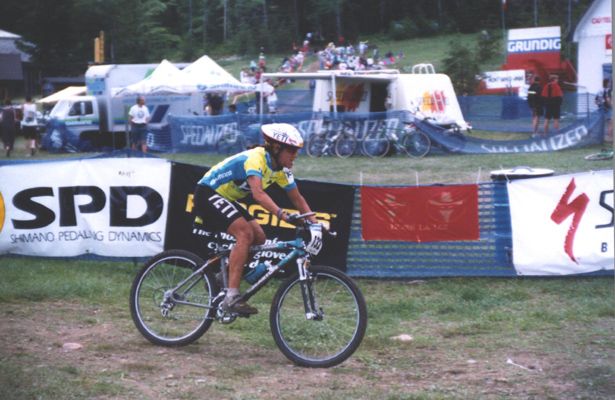
In the States for a World Cup. Not sure where this is, but it's probably Traverse City or Hunter Mountain. Oakley frames are unique to this race. Still has the Bradbury fork.
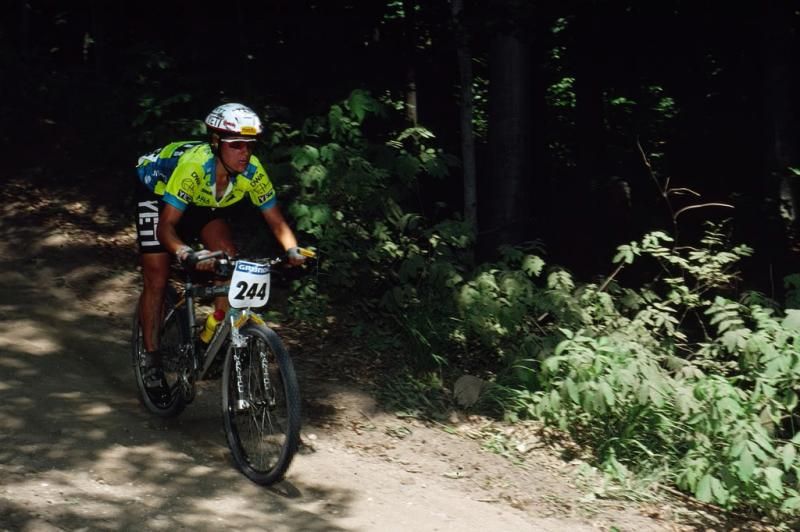

Not sure where this falls. It's kitted out like one of her race bikes with her name on it, but that's it. It has the later cable stops and a carbon accutrax. Clearcoated frame with alternate Yeti decals. I find it hard to believe this was a race bike.
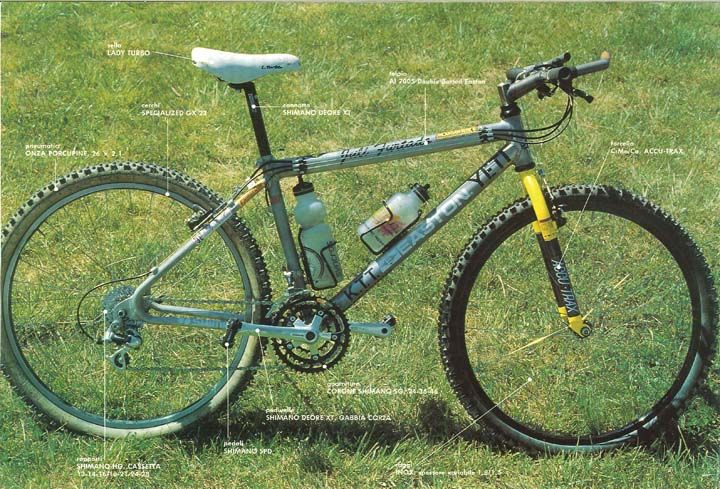
Mammoth World Cup. Now in the Grundig leaders jersey. Still using XT, so probably mid-summer before XTR was available. Has a newer, Answer-made Manitou fork and Panaracer Smokes, despite Onza being a team sponsor
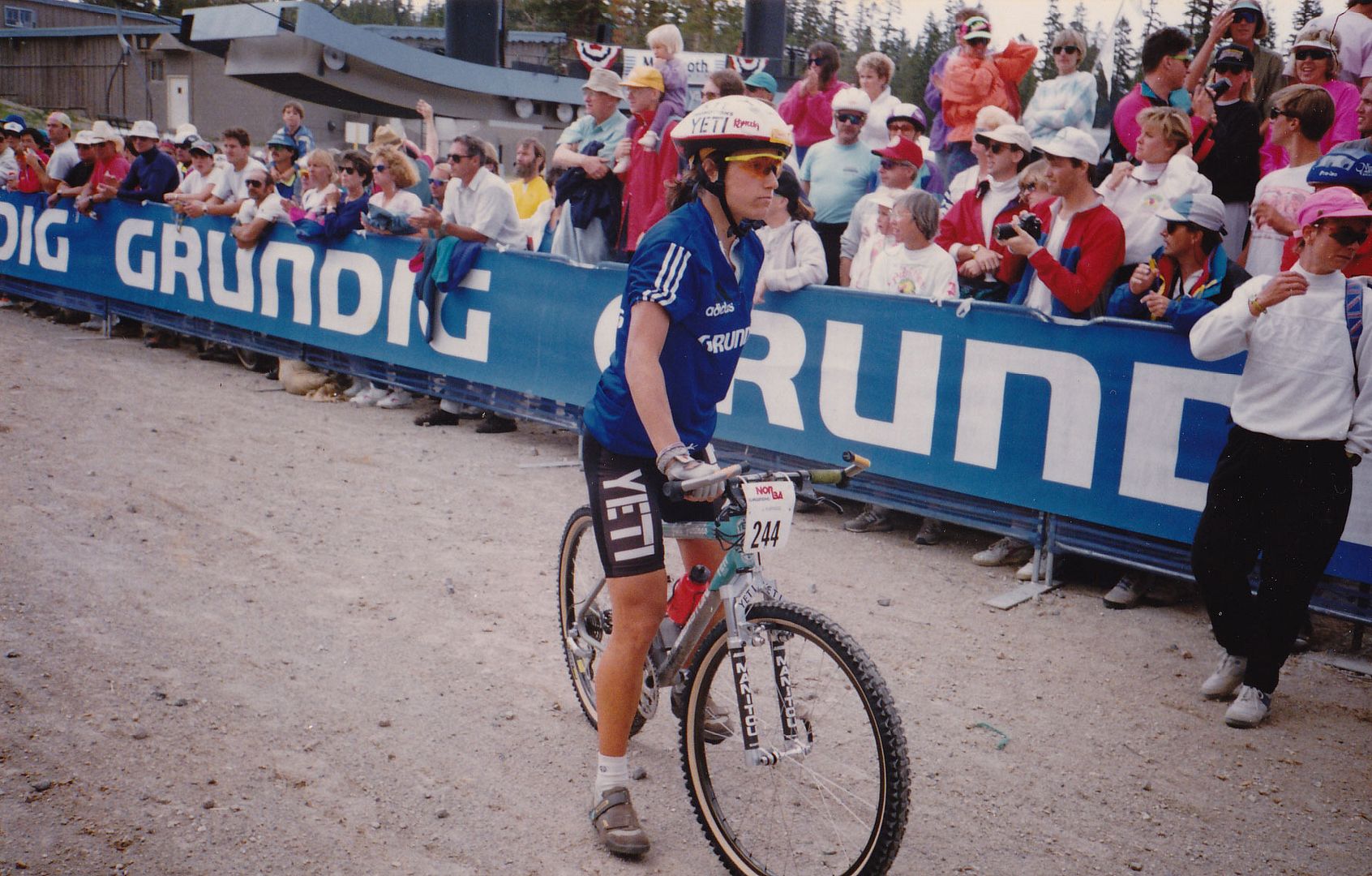
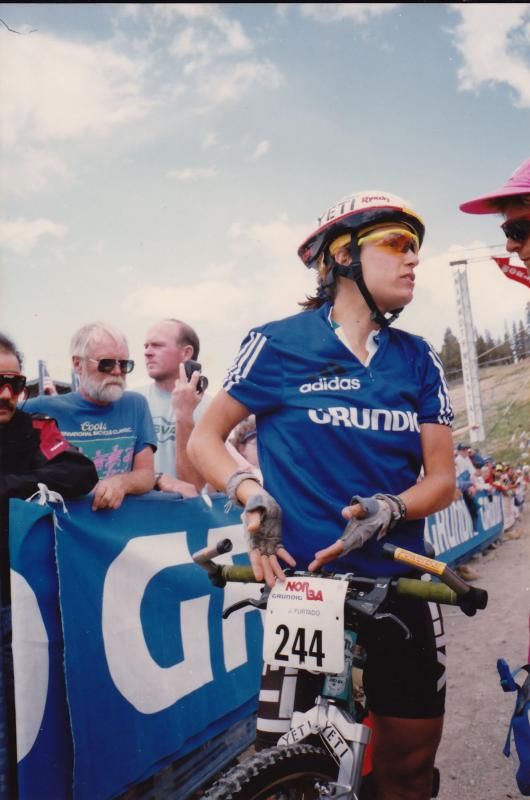
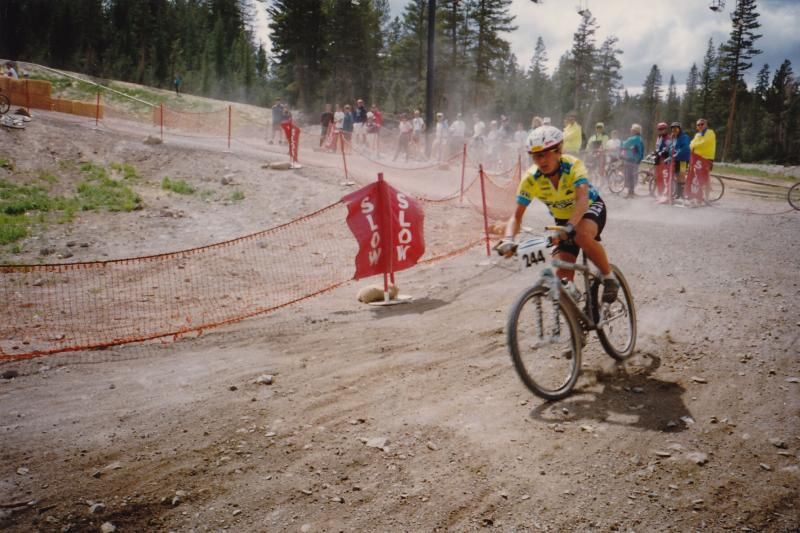
Here is particularly strange photo. It's mammoth, but they're putting the Grundig jersey on over her Yeti jersey.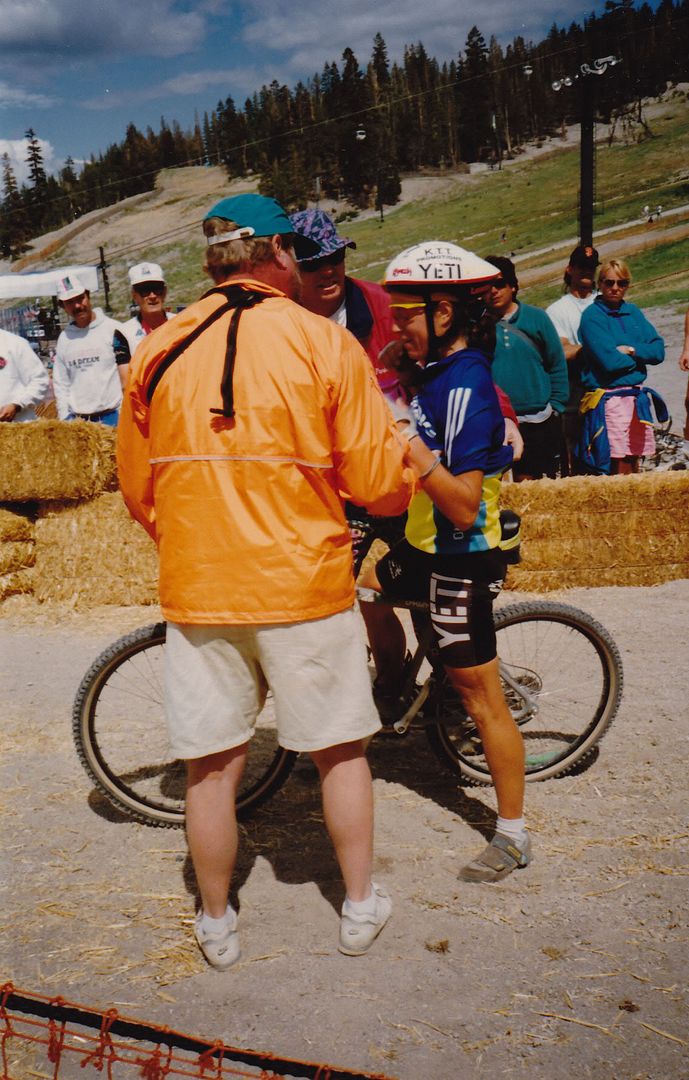
I dont know where this World Cup race is, but it's the first we see of her new XTR parts. my guess would be Sierra Nevada, Spain.

NORBA finals at Mount Snow, Vermont. Lots of changes. Notably she's wearing the NORBA jersey, and my theory is that this was required for the finals. Purple Ringle post and skewers, XTR, but back on Porcs? A lesser race program would probably just have run whatever, but Yeti did what they could with what they had, sponsorship be damned it seemed.
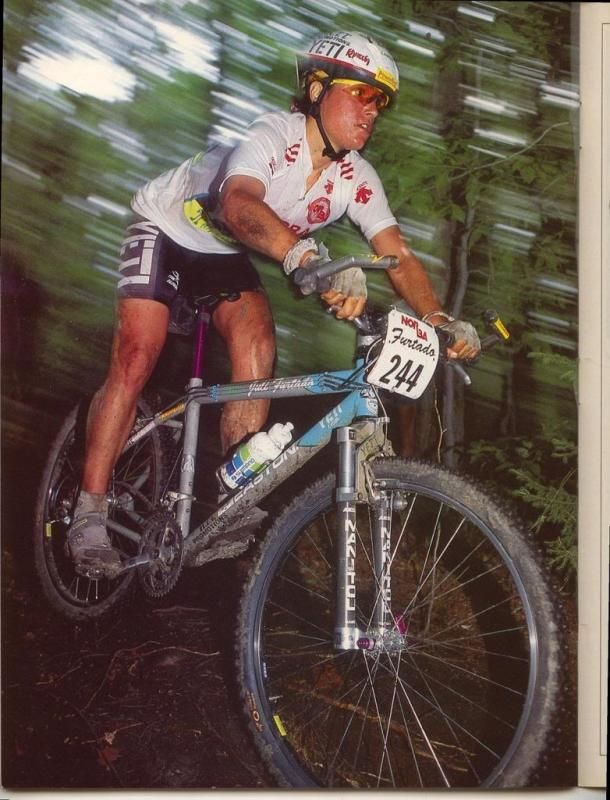
With Parker, post race. Looks like a team-cut ATAC

Back in Europe for another late season World Cup. This time in the WC stripes.
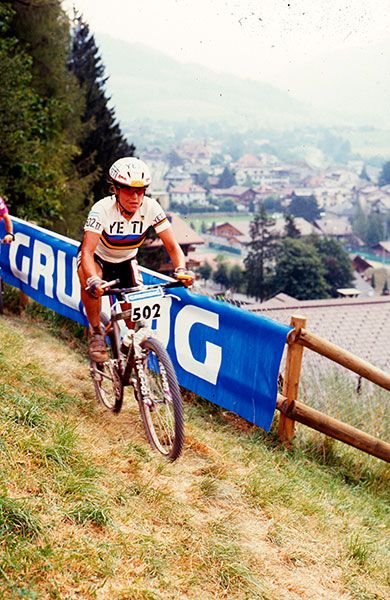
XTR, with a dangerously low front straddle cable. Porcs and Smokes. Looks like a team-cut ATAC stem

Looks like the same race
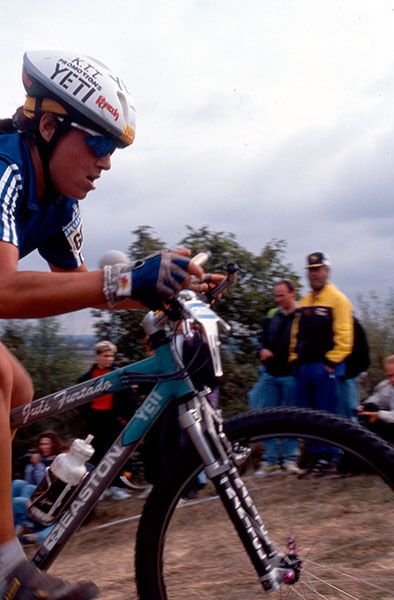
This is a french magazine article featuring Juli's bike. This is a very early ARC and notable for the fact it has a FRO-like one-piece rear end. I've never seen a single other ARC frame like this. Other key frame details include the enclosed top tube cable stops, black Yeti decals, and black Furtado decal. Specialized Ground Controls which she would drop soon for Onza Porcs.



First race photo from the season. She's in world champion stripes, a jersey she would seldom wear during the year. Juli wore four jerseys that year: Standard Yeti, NORBA series leader, Grundig World Cup leader jersey, and World Champion. Juli says the day's jersey decision was made for her, which I always found odd. But it illustrates her loyalty to her sponsor. Here she's in her WC stripes. Looks to be same bike from the french mag. Doug Bradbury Manitou (pre-Answer) fork. Drops the thumbshifters as well for Rapidfire M092? units.


Big Bear, likely May 1991. No obvious changes to the bike. Decal placement suggest she's still race the early bike with the FRO-like rear end. The Onza ad also shows a loop near the bottom bracket which supports this.



This is one worth taking a second look at. Who is this ad for, Onza or Panaracer? There are two different, competing products from two differing companies being promoted in the same ad? What's also interesting is that this is clearly Big Bear and at this race she had Onza decals on her bar ends, yet these decals seem photoshopped out (years before that was possible).

Iron Horse Bicycle Classic, Memorial Day, May 1991. First we see of a bike change, and some key component changes as well. Frame has white Yeti decals and cleaner cable stops. Gone (temporarily) is the steel FTW stem for what looks to be a team-cut Answer ATAC. One would think this would be a perfect race to showcase the World Champion jersey, but nope.

An unknown World Cup race. Looks like bike #2 with a steel Yeti stem back on. Early race since she doesn't have the leader's jersey.

In the States for a World Cup. Not sure where this is, but it's probably Traverse City or Hunter Mountain. Oakley frames are unique to this race. Still has the Bradbury fork.


Not sure where this falls. It's kitted out like one of her race bikes with her name on it, but that's it. It has the later cable stops and a carbon accutrax. Clearcoated frame with alternate Yeti decals. I find it hard to believe this was a race bike.

Mammoth World Cup. Now in the Grundig leaders jersey. Still using XT, so probably mid-summer before XTR was available. Has a newer, Answer-made Manitou fork and Panaracer Smokes, despite Onza being a team sponsor



Here is particularly strange photo. It's mammoth, but they're putting the Grundig jersey on over her Yeti jersey.

I dont know where this World Cup race is, but it's the first we see of her new XTR parts. my guess would be Sierra Nevada, Spain.

NORBA finals at Mount Snow, Vermont. Lots of changes. Notably she's wearing the NORBA jersey, and my theory is that this was required for the finals. Purple Ringle post and skewers, XTR, but back on Porcs? A lesser race program would probably just have run whatever, but Yeti did what they could with what they had, sponsorship be damned it seemed.

With Parker, post race. Looks like a team-cut ATAC

Back in Europe for another late season World Cup. This time in the WC stripes.

XTR, with a dangerously low front straddle cable. Porcs and Smokes. Looks like a team-cut ATAC stem

Looks like the same race

Wednesday, January 28, 2015
Yeti C-26 - Post 1 of 3 - The Infosite & History
In 2007 I created the website www.Yeti-C26.net as a source for all things C-26 related. The history, the bikes, and to document the rebirth with my bike. Back then, not a whole lot was out there about these bikes. Hardcore collectors knew their value but very few were known to exist. 8 years later, the C-26 is arguably the most popular vintage mountain bike, especially since they're now being semi-frequently replicated. Interests and priorities change, and sometime around 2011 I decided I no longer felt like paying a monthly and yearly fee for hosting and domain names, so I took the site down. I was also unhappy with a lot of the information I had posted that was told to me to be truth when photo evidence proved otherwise.
Now, with help from John Parker, Martin K over at Second Spin Cycles is publishing an in-depth look into the early history of Yeti. In tandem with his efforts, I'd like to re-offer the content of my website on this blog and correct some of the errors I had published years ago. In addition, although I may no longer be the expert, now that I've "been there and done that" I'd like to offer a more mature look at this project that never really saw production phase. The next three blog posts will replace all the content that was on that site.
And it should be known to anyone reading this that I am extremely grateful to my friend Chris Herting of 3D Racing Bikes for 8 more years of storytelling, opinion giving, and lending a guiding hand whenever his time allows.
Upfront, I'd like to address the primary discussion points surrounding these bikes.
Here is the text from my original website with some errors fixed.
Now, with help from John Parker, Martin K over at Second Spin Cycles is publishing an in-depth look into the early history of Yeti. In tandem with his efforts, I'd like to re-offer the content of my website on this blog and correct some of the errors I had published years ago. In addition, although I may no longer be the expert, now that I've "been there and done that" I'd like to offer a more mature look at this project that never really saw production phase. The next three blog posts will replace all the content that was on that site.
And it should be known to anyone reading this that I am extremely grateful to my friend Chris Herting of 3D Racing Bikes for 8 more years of storytelling, opinion giving, and lending a guiding hand whenever his time allows.
Upfront, I'd like to address the primary discussion points surrounding these bikes.
- The recently made C-26 bikes are fakes. This is untrue. The "C-46" bikes are identical to the bikes produced in the Agoura Hills factory. The same methods, materials, and hands were used to make these bikes. In fact, given the lugs are individually hand-spun by Herting and not sourced in bulk at a machine shop makes these bikes more credible than the kit C-26s. No "modern" technology is used. The glue used to today was available, and should have been used, only they used the 3M Permabond with poor results. The only difference between is 25 years of mountain biking history. Obviously 25 years of race heritage and ownership changes cannot be replaced and will clearly affect value. But discussion of value aside, these are real C-26s.
- Why did the C-26 fail? The easiest and likely best answer is that it failed because Parker and Herting never put forth the effort to properly develop the design. Parker was sold with the idea that it would be lighter and easier to make than a steel bike. In truth, it wasn't that much lighter. My C-26 frame is a half pound lighter than a regular FRO, which isn't amazing considering how much effort it took to make one. The carbon-stayed version would have seen slightly more weight savings, but not much. And using "kits," the bike would likely have been easier to assemble, but by the time it came to put these into production, Parker had found significant weight savings with the ARC tubeset. Yes, most of the original C-26s broke. The tolerances Easton claimed they were using just didn't work, and most of the glue Herting was told to use simply was squeezed out as the bond was made. This could have been easily fixed, and we all know bonding works as Trek had been doing it for years. But the prototype C-26 took weeks to make, and I'm sure it didn't help sell Parker on the longterm viability of the bike when his salaried staff was spending all day playing with glue when they could have been welding frames. The design was also flawed in that the steel lug and aluminum sleeve will force the bond to break because of the difference in expansion and contraction rates of the two metals. Hot summers and cold winters should break the bond. But strong C-26s have been made. There is a kit bike assembled in Durango that now lives in California that's been ridden regularly for 20 years, and it is sound. The technology works, it just takes patience to get it right. I believe the kit bikes were all sound bikes and could have worked fine with the right glue.
- Why are we even talking about these bikes? A lot of small companies had small runs of prototype-level bikes that aren't nearly as popular as the C-26. Examples that come to mind are the Kestrel Nitro and the Fisher Alembic. The C-26 wasn't even using envelope-pushing technology. I think a big reason is the Ford Edsel-like story the bike has, where it was hyped by MBA as literally the best bike they'd ever ridden and the "next big thing," only it became anything but. Juli winning worlds and Tomac riding a few with drop bars helps. But ultimately, I think because they're rare and get five figures on ebay, collectors need them in their garages, so the rest of the world is left to chat from the sidelines.
- Only ten bikes were made? This is sort of true, depending on your point of view. Yeti only made 10 or less bikes. But many kit bikes were assembled. I know of or have on good authority the location of at least 20 complete C-26s. And another10 or so recently-made bikes.
Here is the text from my original website with some errors fixed.
“History is full of
occasions when two parties with radically diverse backgrounds have gotten
together to create something that actually represents the best interests
of both of them… the Yeti Bicycle Company and corporate giant Easton
Composites is [one]. The union is one that not only represents the
interests of both parties involved, but also every mountain bike
enthusiast around the world who is yearning for What could possibly be one
of the greatest performing mountain bikes ever made.”
-MBA June 1989
Possibly the greatest cause for the mystery behind the C-26 is the lack of
consistent, accurate information available about the creation of the
frames. Even the key players involved cannot agree on certain pieces of
information, like exactly how many frames where built, and to whom they
were given/sold. One verifiable fact is unchallenged: Around 1987, Easton
Composites began development of a new tubeset using carbon fiber and
aluminum. The technology had been utilized for some time in Easton’s line
of archery and hockey equipment, and it wasn’t long before it saw
potential for application in the burgeoning and lucrative world of
off-road cycling. As Easton Engineer Chuck Texiera more aptly put, said,
“we should make a bike out of this stuff.” After some R&D work, the
result was Alucarb, also known as the Easton C9 Tubeset. The
“carbon” tubes that composed the main front triangle were actually
aluminum sleeves wrapped in a Kevlar/carbon weave. They were advertised
as extremely light and forgiving, yet stiff enough for a NORBA race
machine. Raleigh Cycles utilized the design in its 1988 Vision bike, and
sales proved the design was a hit. Eventually, the success of the Raleigh
line pushed Easton Sports to market the design for its in-house brand,
Reflex. Easton marketed Reflex for a short while before selling it to
French manufacturer Puegot.
By 1989, California’s Yeti Cycles had established itself
as a major player within the exploding mountain bike race scene. The
company was renowned for supporting racers, using rider input, and
stressing the limits of technology to make faster, stronger race bikes.
Their ungraceful approach, combined with their willingness to take a
chance on just about anything earned them a niche fan base, and made them
the media darlings of the 1990s. Yeti boss John Parker made no apologies
about the weight of his bikes as he designed them to be “bombproof,” but
Yeti partner Chris Herting struggled with the realization his team raced
on inferior equipment. Herting saw no reason the Yeti race team
should be forced to compete against riders on bikes three to five pounds
lighter. After the 1988 race season, Herting realized parts could be drilled out only so much before
risk of failure was too great, and he began seeking alternate ways to
lighten the Yeti “For Racing Only” team frame.
Easton came to Herting with the idea to use C9
carbon tubes on Yeti race bikes, and Herting proposed the idea to Yeti
boss John Parker. Famously stubborn Parker hated the idea at first and
vowed to stick with Chromoly steel. However, once Easton engineer Chuck
Teixeira suggested the carbon frames could be easier to
manufacture, Parker gave Herting the green light to produce a prototype.
They called it the Yeti C-26 as for Chris’ initial and his age at the
time. The design was complicated, but not revolutionary: The Easton C9
carbon-tubes would be mated to hand-machined steel lugs using a special 3M
compound (Permabond 310), which would then be then cured in an oven (275
degrees at one hour to be exact). The classic steel BMX-style one-piece
Yeti rear end would then be welded to the new formed, ultra lightweight
front triangle. With the Yeti’s marketing machine at full throttle, and
some help from Mountain Bike Action, the prototype C-26 was dubbed
“the future of mountain bikes.”
From the moment Easton delivered the initial
C9 tubes, it took three weeks to complete the first frame, as successfully
joining the tubes and lugs proved to be a disaster. Permabond compound
(glue) was applied to a lug, and before the mixture could harden, the tube
slid over the lug end. However, the ultra-high tolerances between the
lugs and tubes caused most of the glue to squeeze out upon application,
making everyone nervous about the strength of the bond. The problems
continued as each bond needed to be tweaked to meet the Yeti geometry.
After a few minutes, the compound would begin to harden, making minor
adjustments impossible. Mating the later joints would break the bonds set
earlier, and so on. 20 years later, Herting considers building the
first prototype one of the most challenging times in his career.
The first frame was finished in the Spring of
1989 and was given to Mountain Bike Action for test. It would be unfair to
call the review anything but biased, as MBA and Yeti had an ongoing
business relationship with the Yeti Ultimate project. They called it “one
of the most awe-inspiring mountain bikes we’ve ever ridden.” The bike was
given to team rider Russ Worley (who performed the MBA test in a Yeti
jersey). The prototype C-26 appeared in Yeti’s first brochure in 1989,
touting “half the weight and twice the strength” of steel. In the fall
Interbike show, Yeti arrived with the prototype C-26 adorned with team
decals.
Herting’s most prominent memory and quote when asked about the C-26
is, “they all broke.” This is obviously untrue, as many are in good
shape to this day. This flawed memory can only come from years of
negative stigma surrounding the frame. Herting recalls the customer
who bought the C-26 from Yeti was “Mike,” and to this day, he cannot
understand why Mike did not return the C-26, as he is certain it
failed.
In the Spring of 1990, Yeti team rider
Joey
Erwin rode a C-26, and Juli Furtado was given one right before her race at the Worlds in Durango. Erwin likely had two. Tomac had been a successful mountain bike racer
with Mongoose, earning six figures, but was dabbling in road
racing on the
powerful 7-Eleven team. After living in Belgium in 1989, Tomac
was
without a dirt contract for the 1990 season. He called Parker
looking for
a bike to ride, and a handshake deal with John Parker had Tomac
competing
in US Mountain Bike events on the Yeti team. The early part of
the season
was spent on a custom steel FRO, with dual 73/73 head a tube
angles to
match his road bike. In the summer of 1990 he was given a custom
C-26 for
cross country. Later, he received another for worlds cross-country event, and a third for the downhill. These frames were the only C-26s with 1” headtubes,
as his
Tioga sponsorship required his use of their stems (which did not
come in
1.25”). Tomac’s featured road-style drop bars with bar-end
shifters so
his position would mimic that of his road bike. It is believed
Tomac later
said this was at the suggestion of his coach, and it probably
wasn’t a
good idea.
At the 1990 World Championships, the sun began
to set for the C-26. Furtado won on hers, and Tomac took 6th
and 4th in the XC and DH on his. Furtado is visibly and
verbally upset after the race that her seatpost slipped 2”. Herting has offered theories about why (the main one being they used a 26.8 post instead of a 27.2 when they swapped components the day before the race. This can't be true as she raced using her Campy seatpost. So any problems would have been identified already. The likely cause is that they simply didn't cinch down the seat collar out of fear of breaking the milled-out BMX part.
The C-26s returned to California, never to be
ridden again. Parker is said to have thanked God the entire drive home that
Juli’s bike didn’t fail during the race. Herting still is amazed at the risk they took by sending Tomac out on a bike that very likely could have broken at 40mph and injured or killed mountain biking's first million dollar man. Parker never trusted the glue
bond. Easton designers had quoted a certain amount of glue was needed for
a successful bond, but with so much being squeezed out on application, no
one could accurately tell whether the frames were strong enough to last.
He never received positive feedback from any of the designers that made
him comfortable enough to trust the frame under his racers. Parker
shelved the project when a suitable replacement glue could not be found,
and rumors circulated he had already invested in another material designed
to cut weight.
When all was said and done, less than ten
actual bikes were ever made by the hands of the Yeti employees that
designed them. The number of actual bikes made at Yeti is disputed, and
neither Chris Herting nor Frank the Welder can identify an exact number
and to whom they were given. Numbers range from three to twenty. Over
the years, the team frames were sold in online auctions and collector
deals, and some of their locations are known. Here is a list of what I believe were the original bikes:
- The Prototype. Appeared in the 89 Brochure. Given to team rider Russ Worley for the 89 race season. Re-decaled and sent to Interbike in Anaheim in the fall of 1989.
- Joey Erwin's first bike. Raced as late as May 1990. Broken, and now sawed up in a box at 3D Racing.
- Joey Erwin's second bike. Raced in the junior XC and to a World-Championship DH win in Purgatory.
- Tomac's original XC bike. Used with a rigid Accutrax fork. Sold on ebay in 2009 for $12,500.
- Tomac's Worlds XC bike. Sold on Ebay in 2002.
- Tomac's Worlds DH bike. Given to Zapata Espinoza
- Furtado's Worlds bike. Sold on Ebay in 2002
- Chuck Texiera's bike. He still owns it and brought it to the Yeti tribemeet in 2012
In 1991, Yeti packed up shop in
Agoura Hills, California, and moved to Durango, Colorado. Unopened boxes
of C-26 tubes made the trip, but none were ever assembled outside of the
California shop. Easton had delivered enough tubing for an initial run of
50 bikes, but with the project on hiatus, the remaining tubes sat in boxes
in the rafters. Yeti embarked on other ambitious journeys in frame design
over the years, with project involving various alloys and thermoplastics. In 1991, Yeti achieved its weight-loss goal by again joining forces with
Easton to develop the aluminum ARC (Alloy Racing Composite), and a
production carbon bike was never thought of again. Chris Herting left in 1992 and restarted his brand 3D Racing, which he owns to this day.
Over the next seven years, the face of Yeti changed drastically, with the
sale to Schwinn in 1995 and the firing of Parker in 1997. In the Spring
of 1999, Schwinn and Yeti’s parent company Scott Sports closed the Durango
factory. In the mass exodus, the bikes not grabbed by the employees were
tossed in dumpsters, along with complete Ultimate, FRO, and Zephyr
framesets. These dumpsters are said to be the fate of over half the C-26
tubesets (except those grabbed by Fritz.. see 'Rebirth').
In the ten years since Yeti closed in Durango, mountain bikes have grown
old enough for some of them to earn the terms “vintage” and “classic.”
Along with several other bikes built by Yeti, the C-26 has taken a
“cult-like” status among collectors, and some consider it to be most
highly desired vintage mountain bike frame in existence.
Tuesday, January 27, 2015
Yeti C-26 - Post 2 of 3 - The Bikes
Chris Herting and John Parker don't agree on much, but they do both claim that very few C-26s were built at Yeti in California. The number ten is generally agreed upon. I have an infinite amount of respect for both of these guys and what they accomplished, but I've seen too many photos of completed C-26s to believe there were only ten frames made. Here's how I categorize complete C-26 bikes:
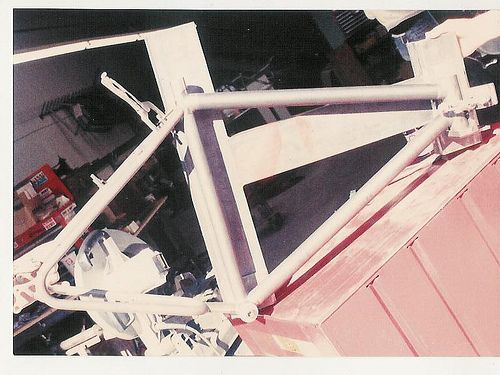
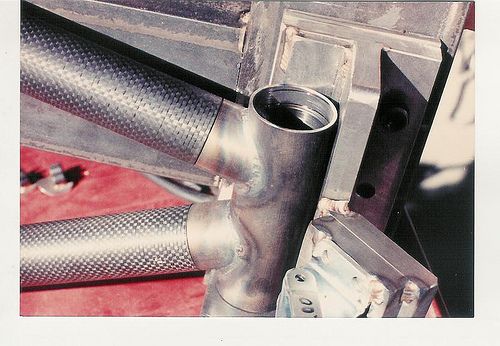
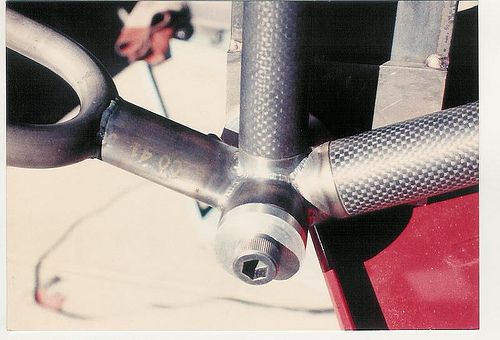
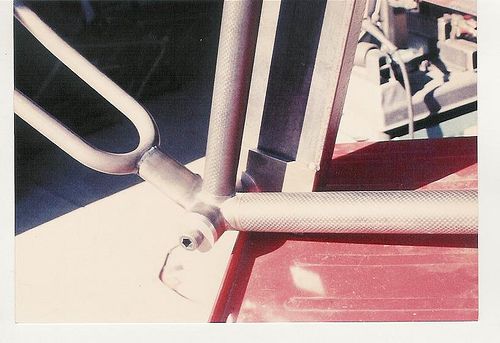
Previewed in the May 89 MBA. "Stronger than Chromoly!" Note the Answer decal on the downtube. This was the only bike made with Simplex dropouts and a the front derailleur operated by the chainstay cable anchor
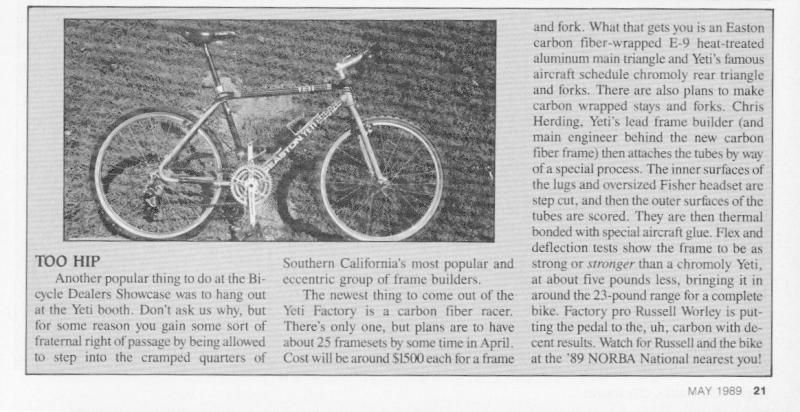
The prototype and early team bikes featured cable stops glued onto the top tube instead of welded to the head and seattube junctions. This is the easiest way to ID the very early bikes. Also note the FTW stem clamped onto the nub welded into the steerer. A different stem than what was on the bike during the MBA test.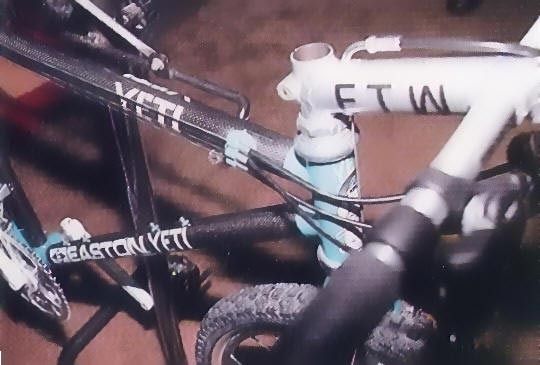
Race duty under Russ Worley. Black Bullseye cranks and red Easton decals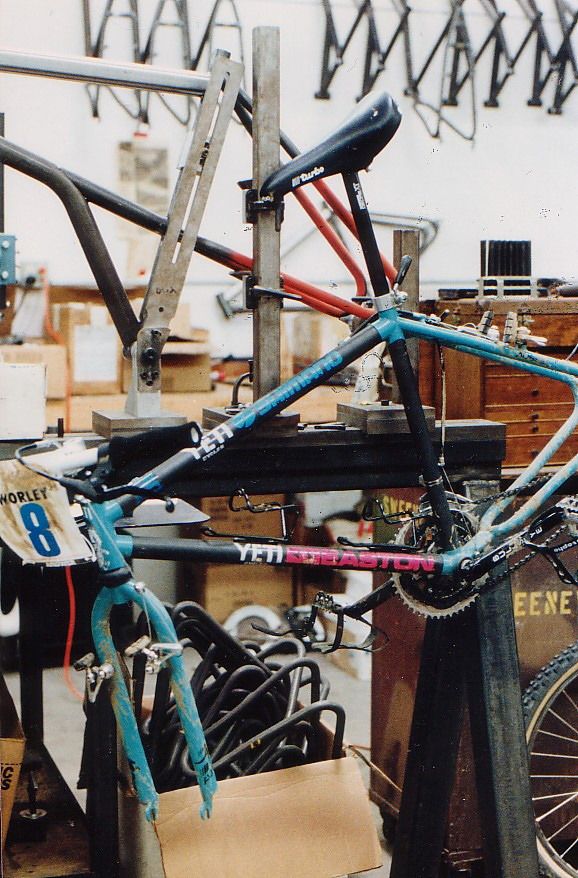
Photo shoot from the 1989 brochure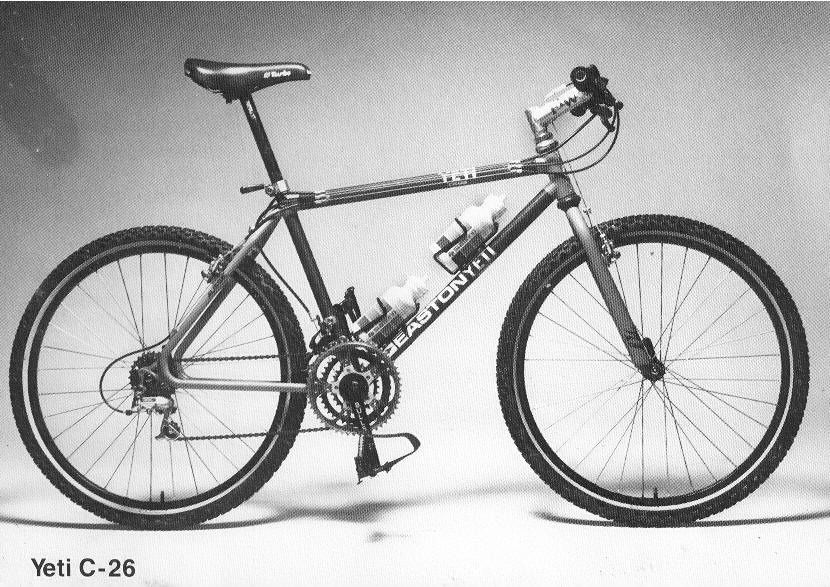
Different version of the brochure shot
Great shot of Worley in the June 1989 MBA Test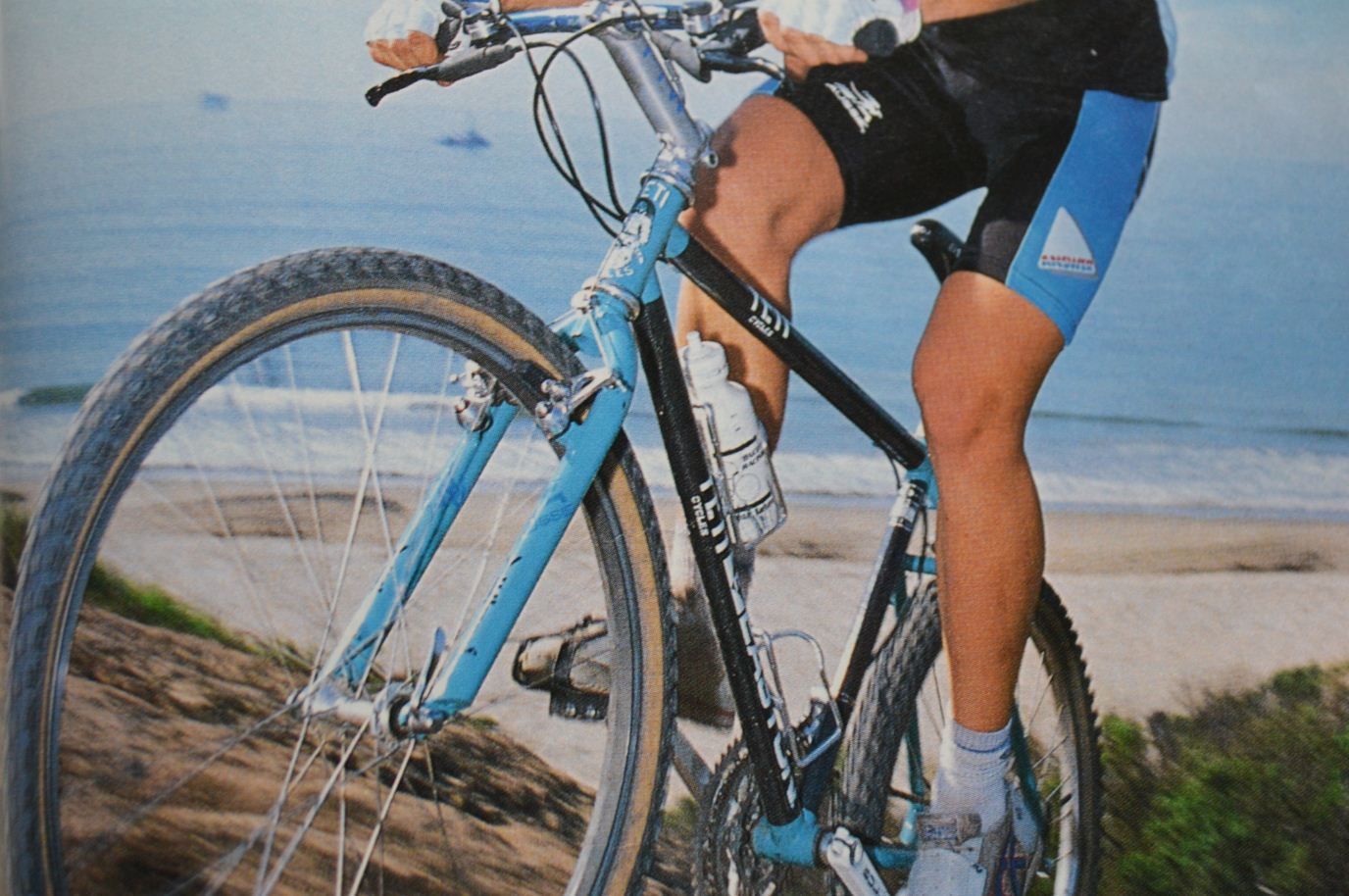
I'll try to put the entire MBA test scan together in order. Favorite quote: "B&W scan from the MBA feature. "The bonding process enables the frame to be taken apart, fixed, and reassembled if the tubes or lugs happen to break."
This would be reassuring on a 50mph fireroad descent. It also happens to be untrue.
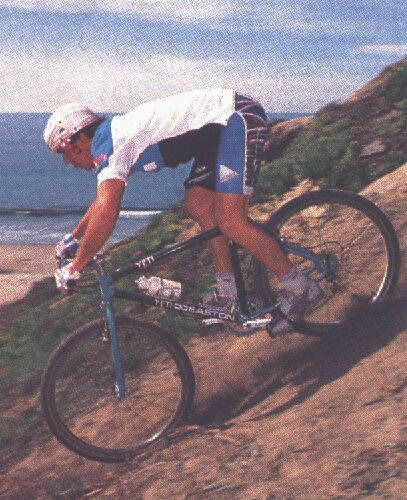
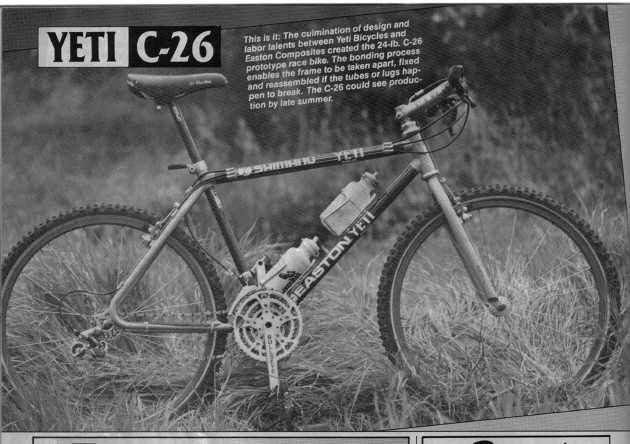

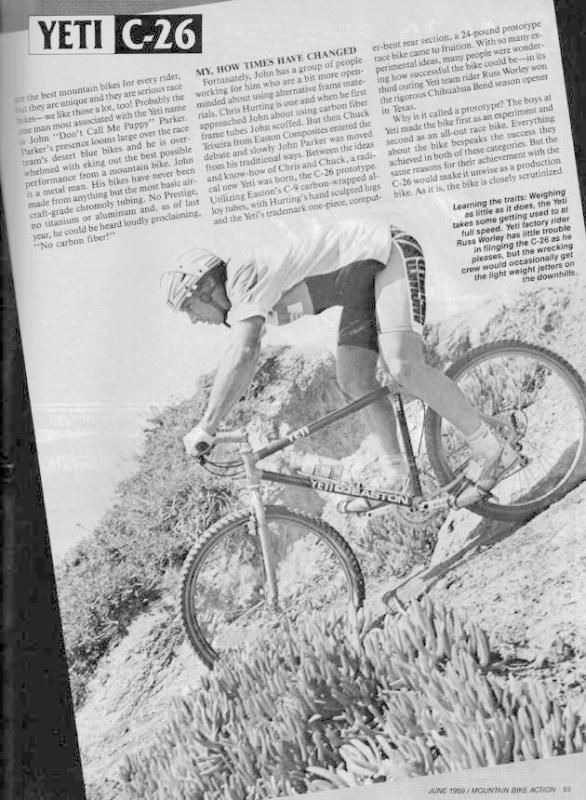
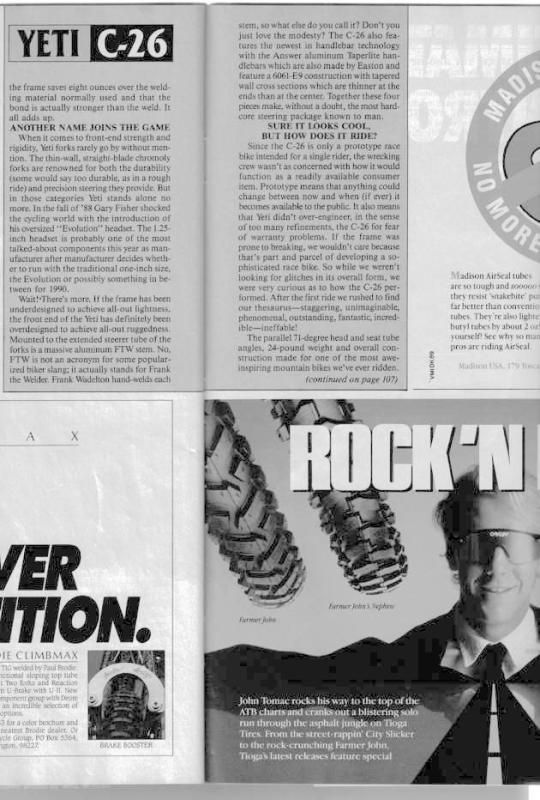


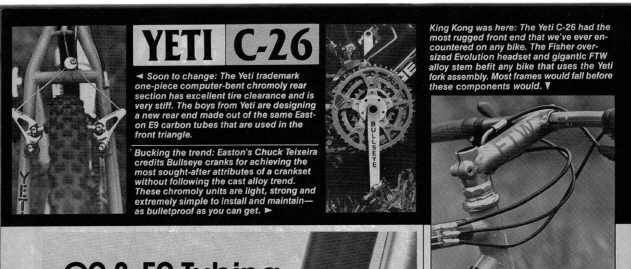

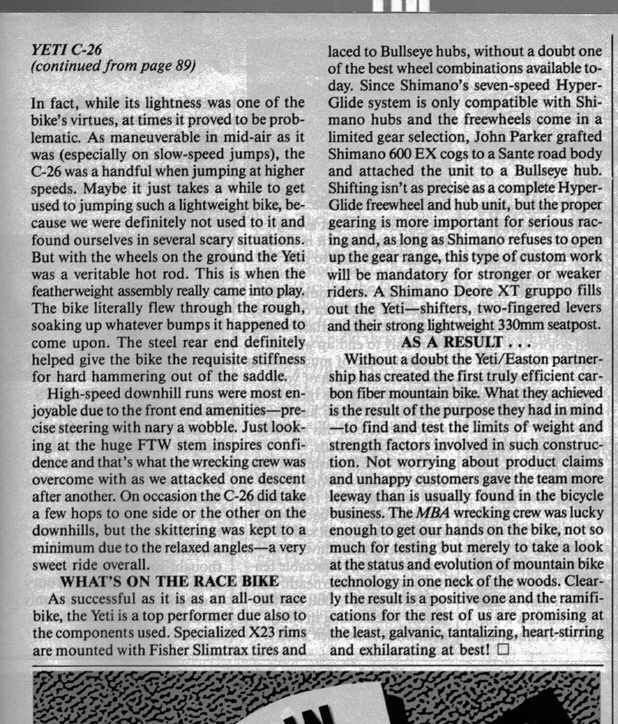
C-26 and Treefrog. Given these bikes are all spiffed (and the FRO with Landshark paint), I'm thinking this is from the Interbike show. Note the custom Chuck Texiera Easton carbon seatpost. He used an SR Laprade head.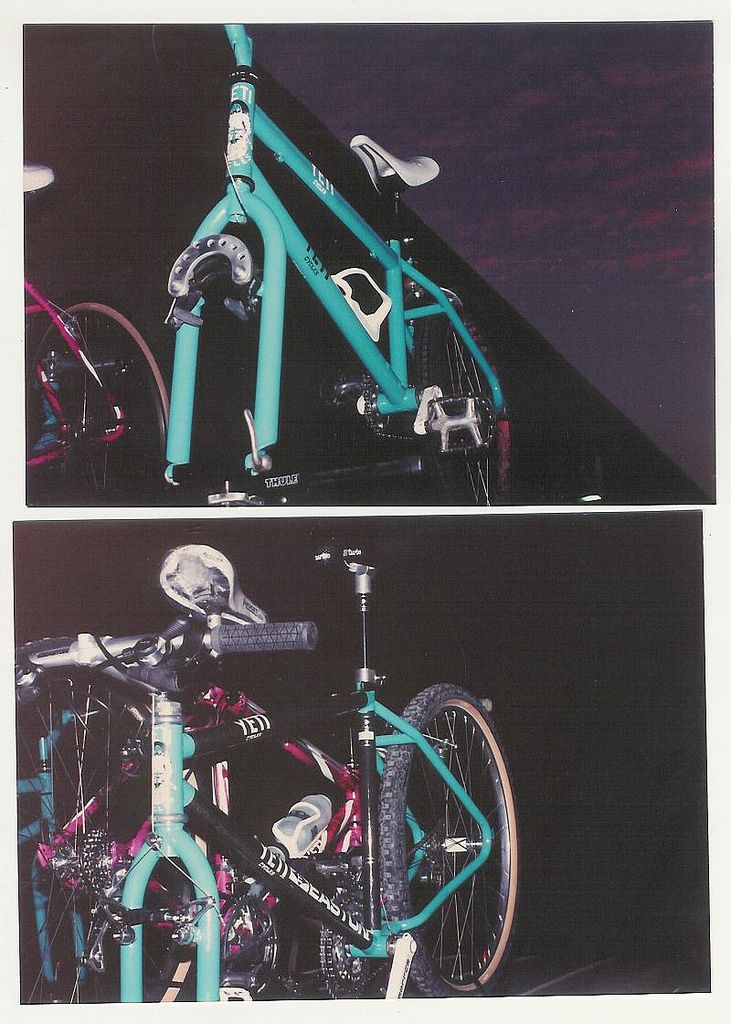
Another from the show?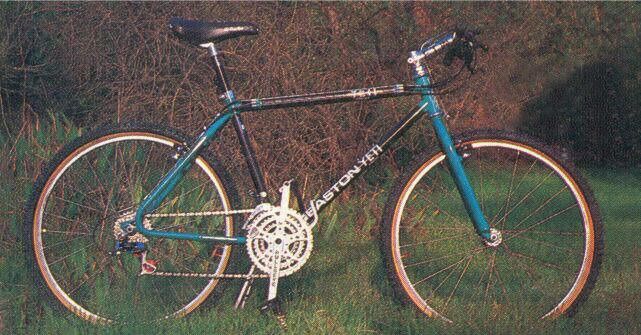
This may be the finest living example of an early C-26. It was a team frame and likely one of Joey Erwin's. It has the top tube cable pads, but the newer style dropouts and the Bullseye derailleur pulley.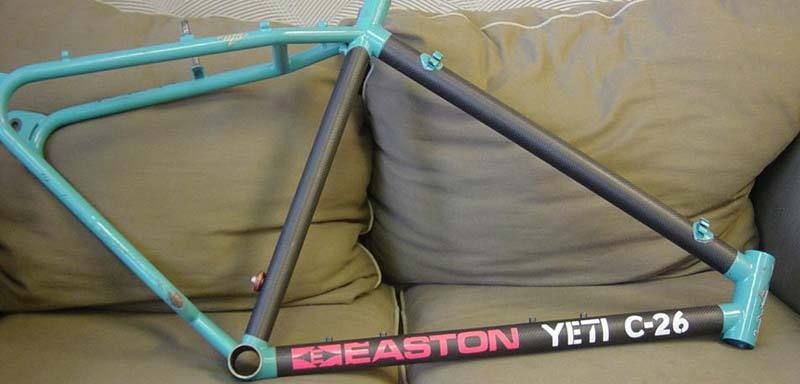
Another Joey Erwin frame. This was taken in May 1990 at the Georgia NORBA National. Erwin is standing next to the fan with everyone looking at his bike.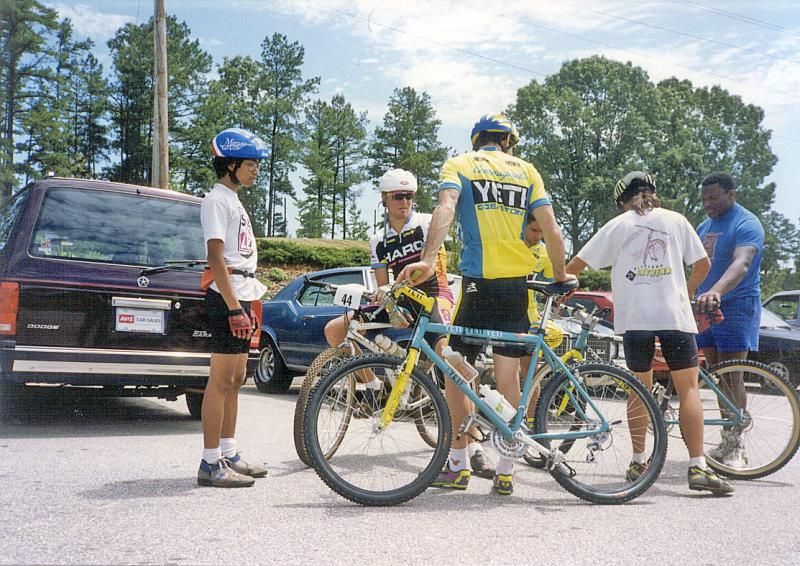
Likely the fate of this bike

In flite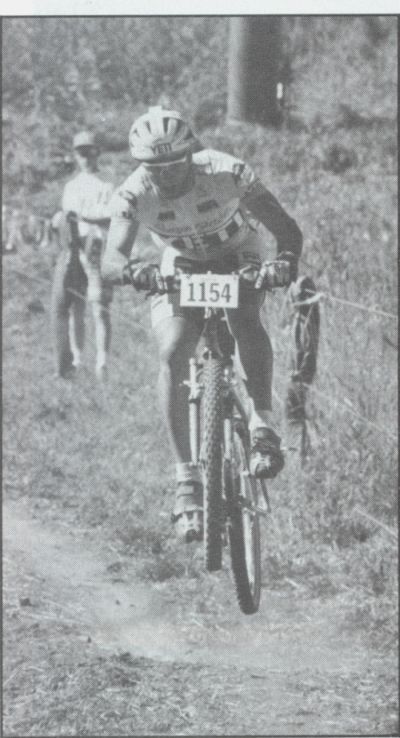
This bike is a mystery to me. Herting traded it with Yeti Cycles for tooling. He says it's a team frame. The noticeable detail missing is the front derailleur pulley hole is missing, which is common with the kit bike frames. However, this is clearly not a kit bike as (1) it has no chainstay triangle fix and (2) it's obviously seen use. It hangs from the ceiling at Yeti. If anyone has any insight, let me know.
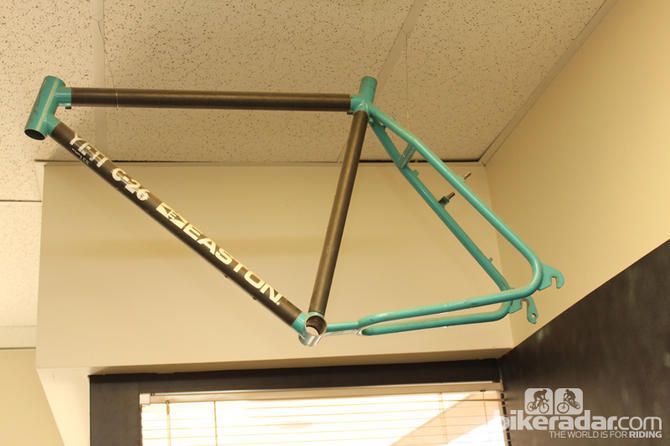

Juli Furtado race bike. My holy grail. This bike won a world championship and none other compares in terms of collectability and overall awesomeness. Sadly sold in John Parker ebay auction in 2002 for $6,800, which was amazing money back then. Completely custom made for her and finished days before the Durango World Championships in September, 1990. Famously converted from Campagnolo to Shimano the day before the race. On a warmup lap likely a day or two before.
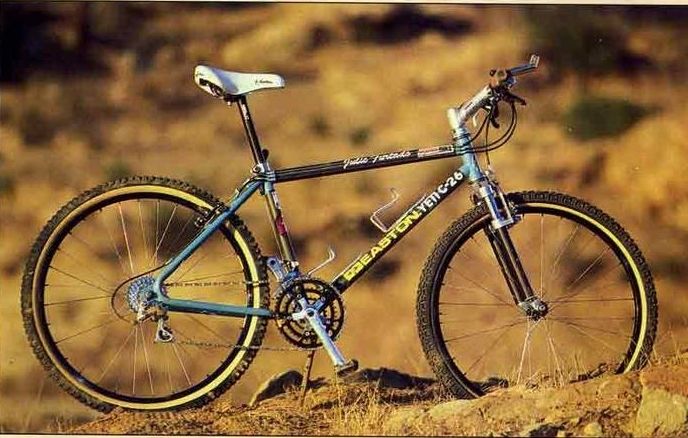
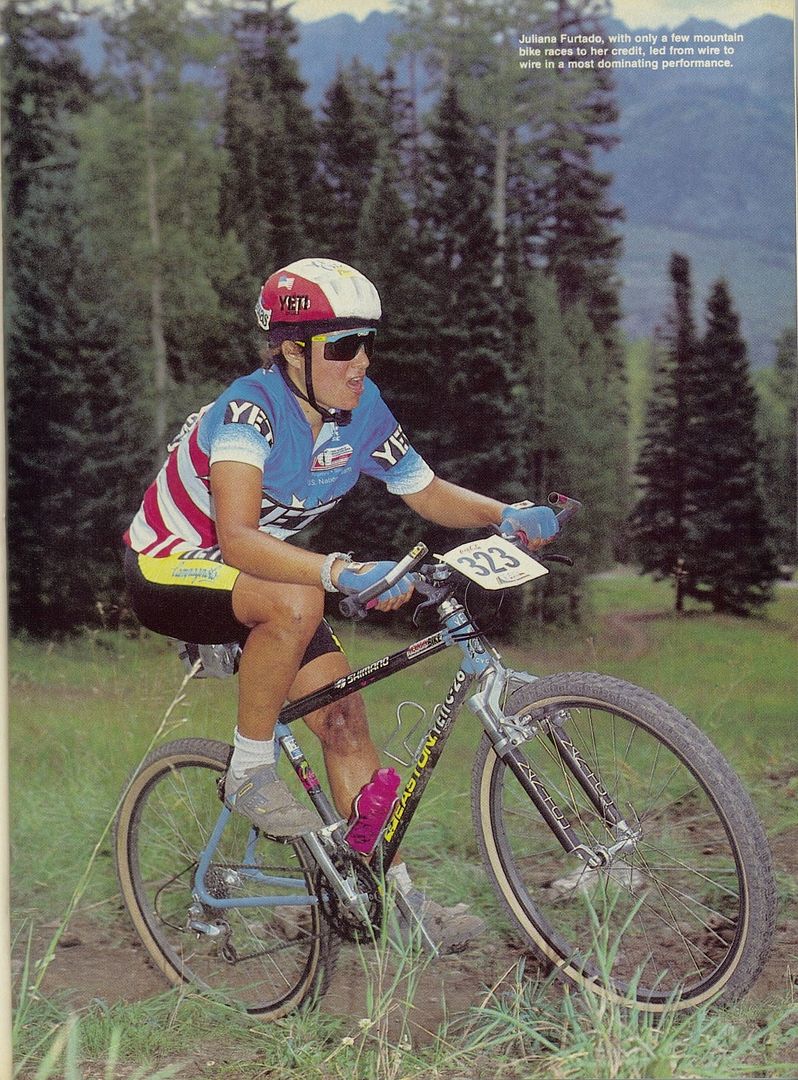
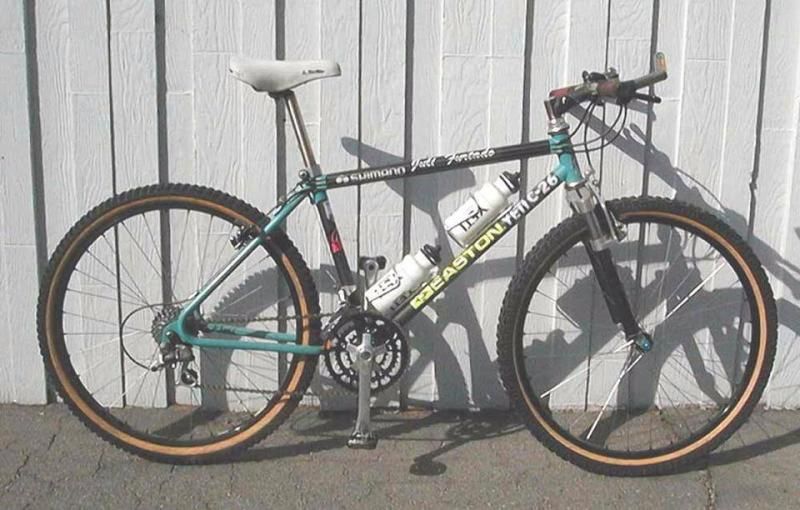
MBA Inside the Pros Bikes article. Note many things were changed for the article including the stem and seatpost.
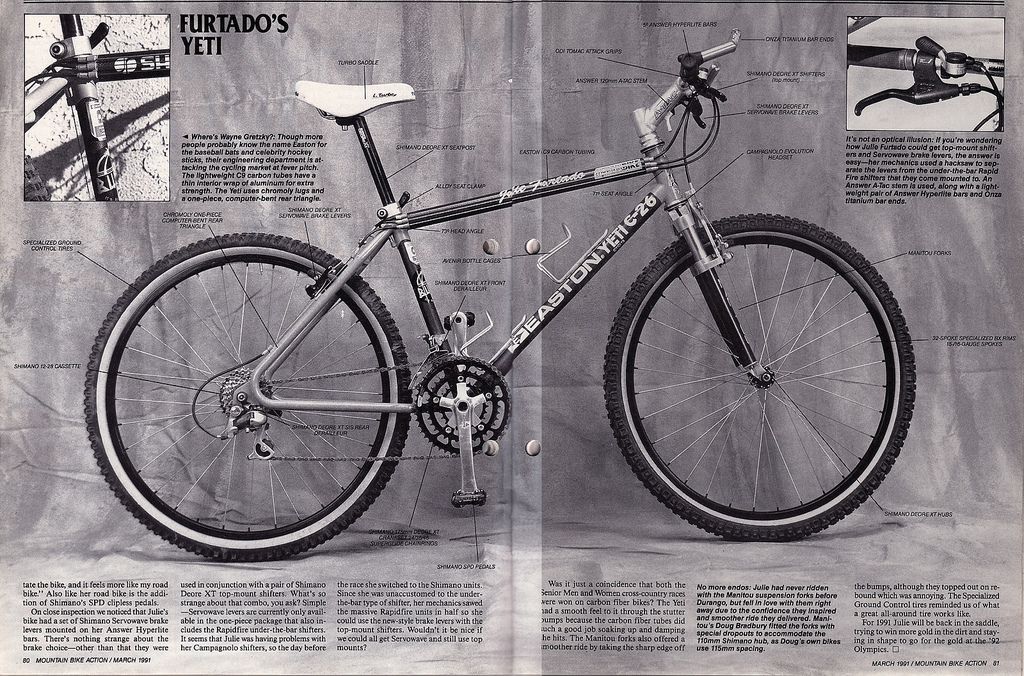 John Tomac Frame #1. Given to him summer of 1990. Sold on ebay in 2009 for $12,500
John Tomac Frame #1. Given to him summer of 1990. Sold on ebay in 2009 for $12,500
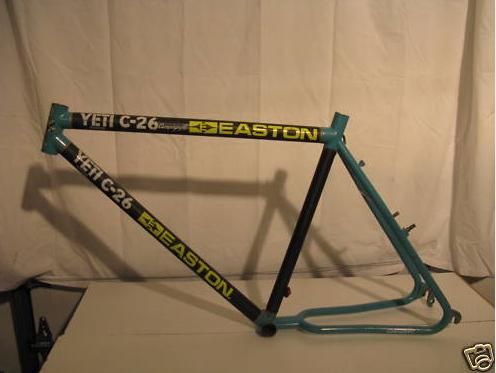
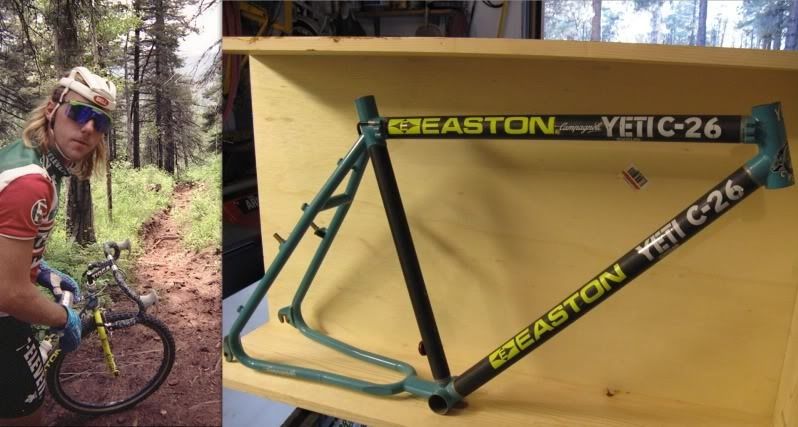
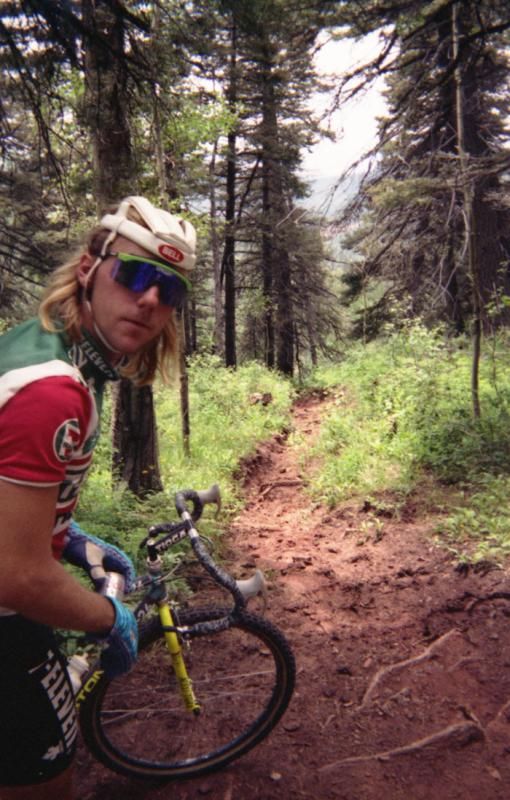
John Tomac Frame #2 - Worlds XC Frame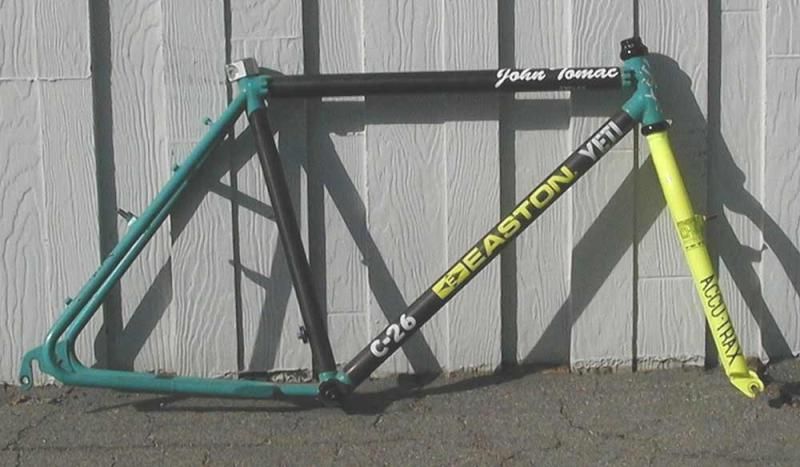
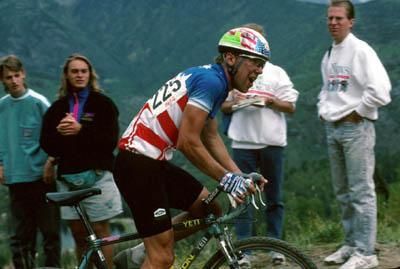
Now residing in Switzerland with a confused build
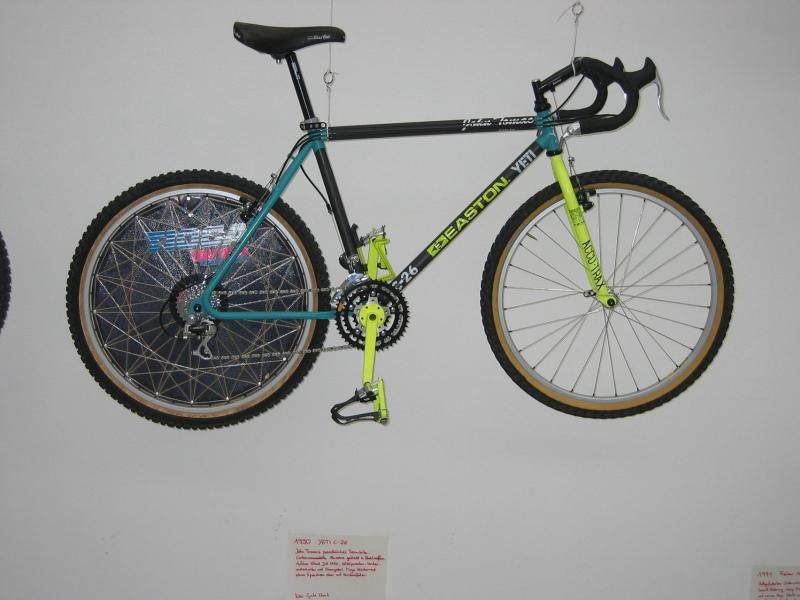
John Tomac Frame #3. Worlds DH Bike.
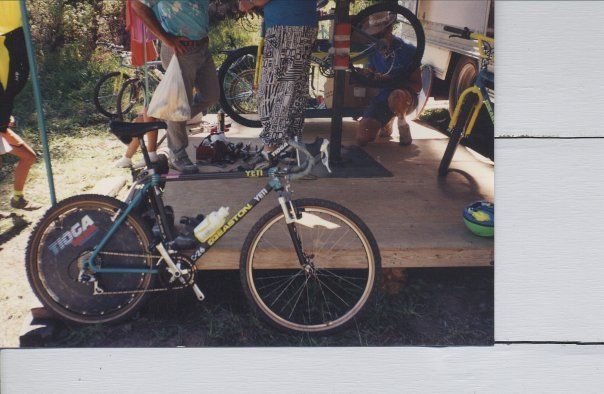
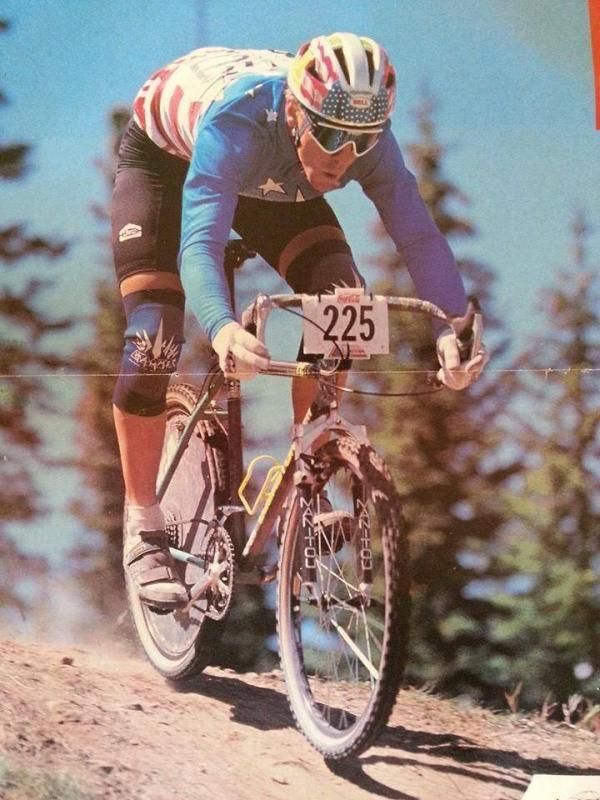
I took this photo in 2008. Chris Herting had the bike shipped to him so he could "copy" it for the Tomac DB-1 limited run C-26 tribute bikes. Amazing to throw a leg over this piece of history.
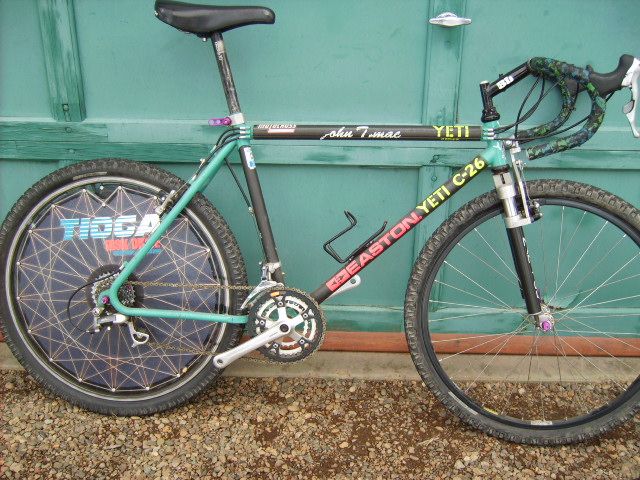 Given to Zapata Espinoza as a wedding present
Given to Zapata Espinoza as a wedding present
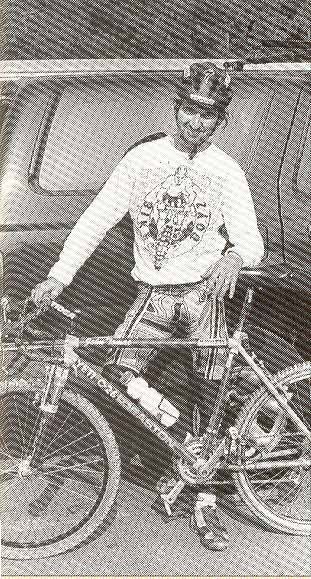
Tested in some UK Magazine. They trashed it in the mud. Incredible.
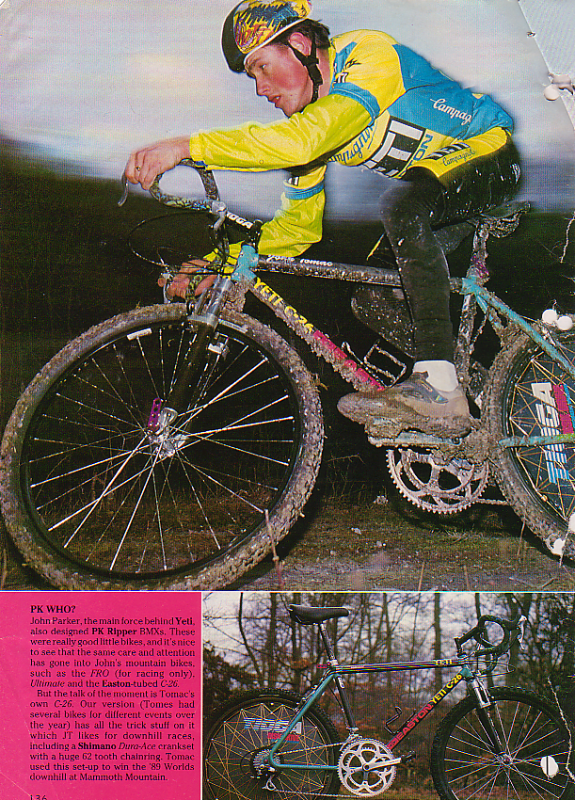
Chuck Texeira complete bike. Chuck was an Easton engineer and the man responsible for the collaboration with Yeti. Features the only other carbon Accutrax I know of other than mine.
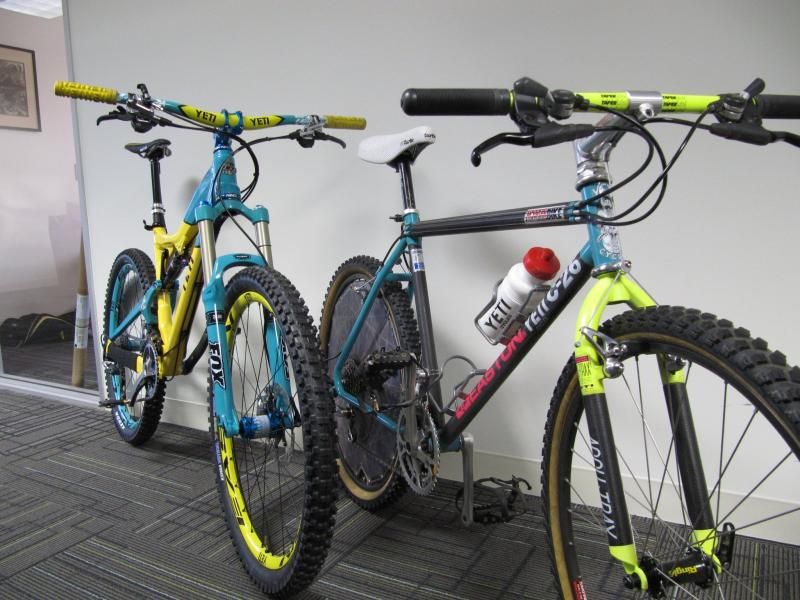
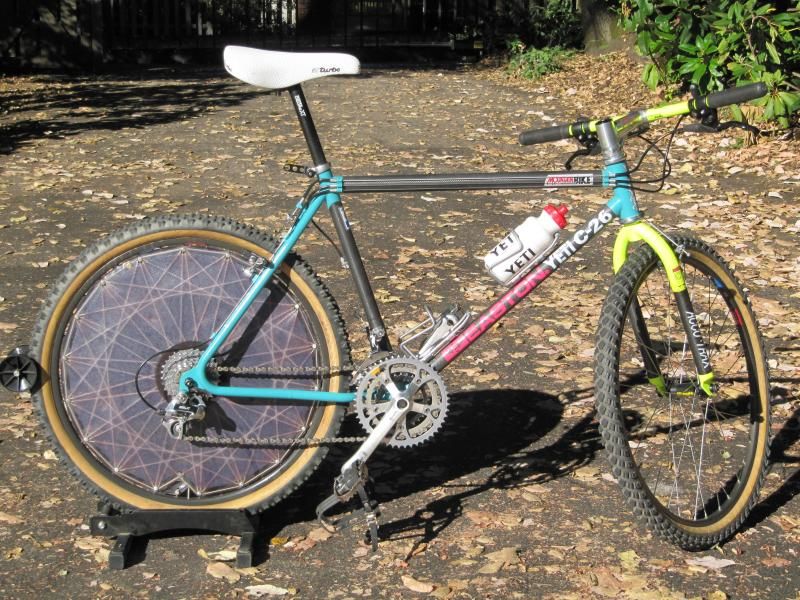
Catalog bike? This was in the 1991 brochure. No idea where this ended up.
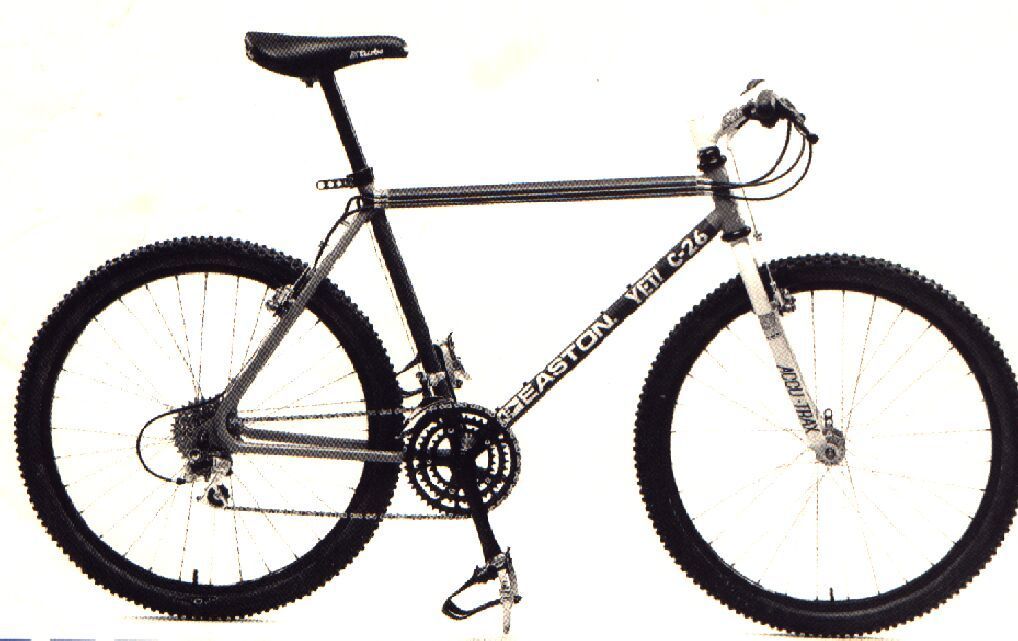
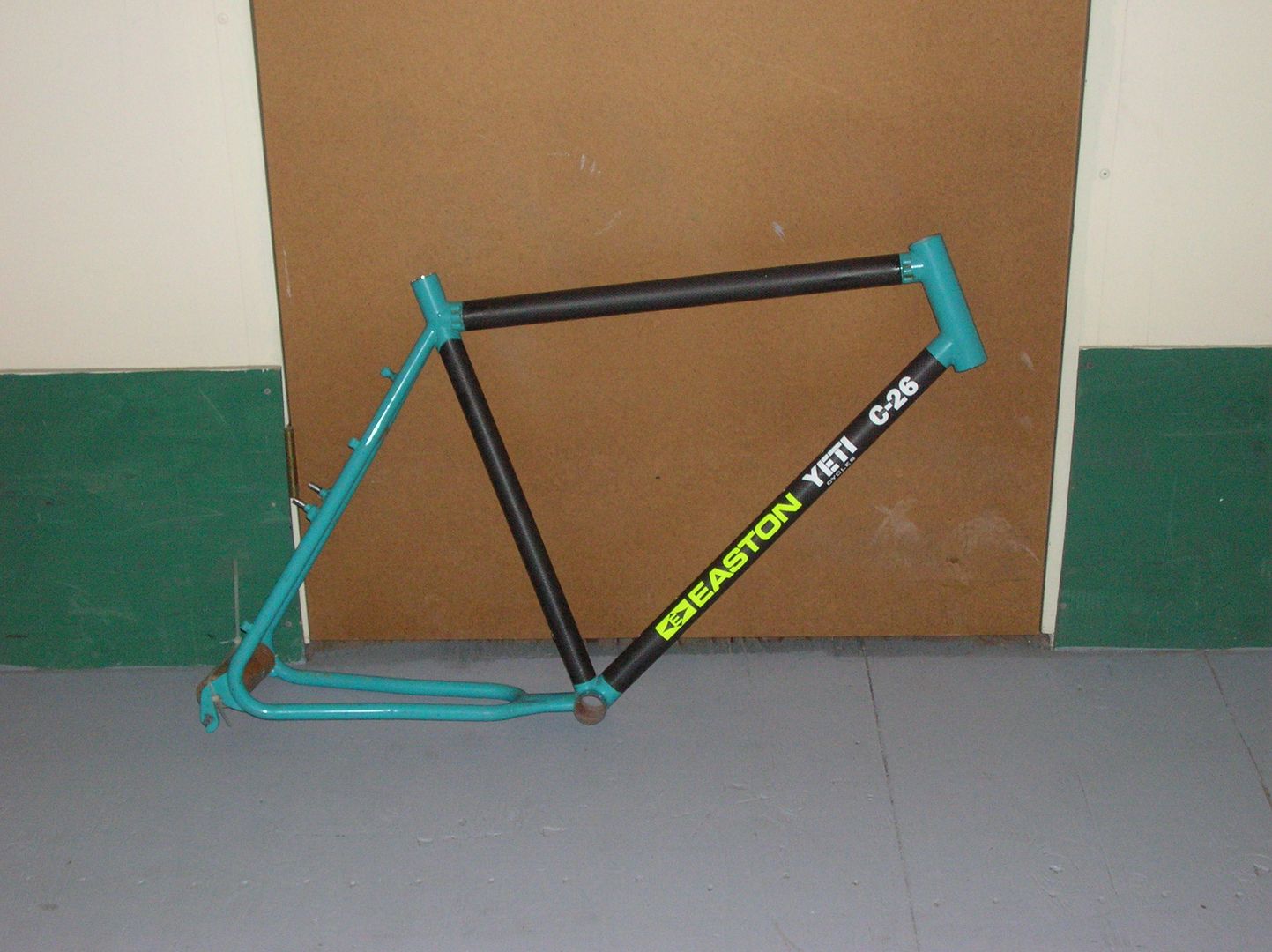
Tomac replica
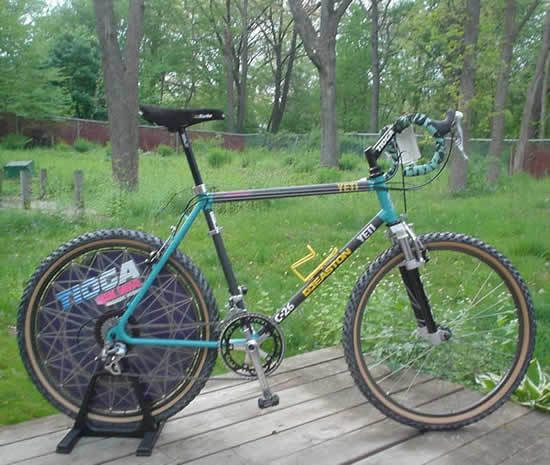
Riveted one
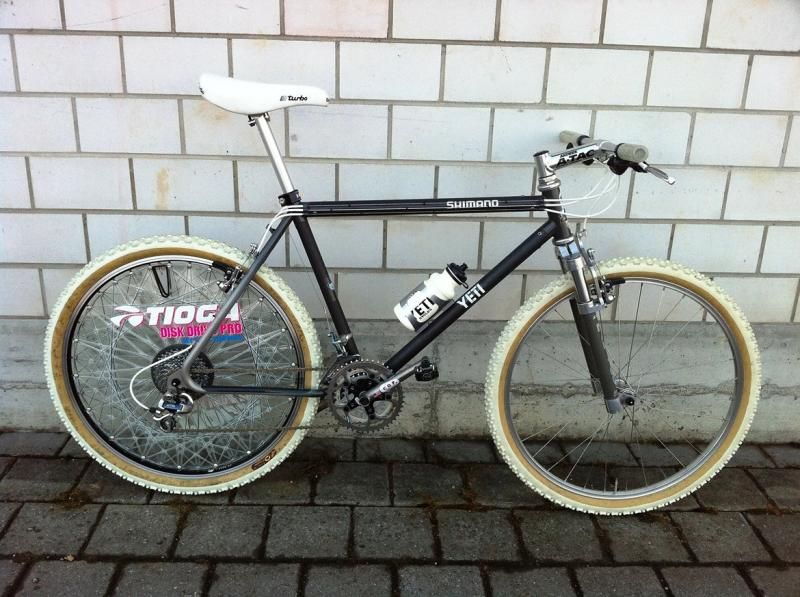
Yikes
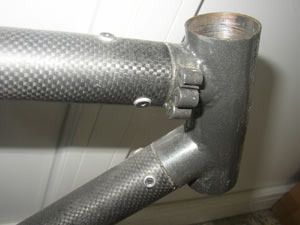
Chris Herting personal frame
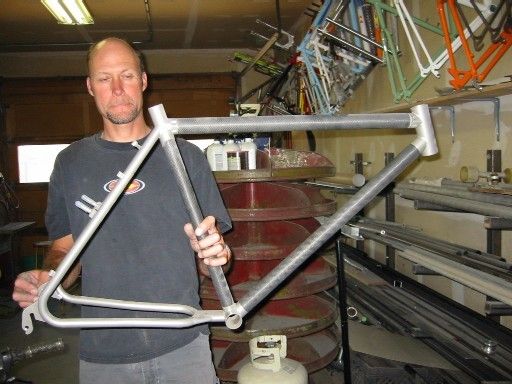
Wish I knew more about this one.
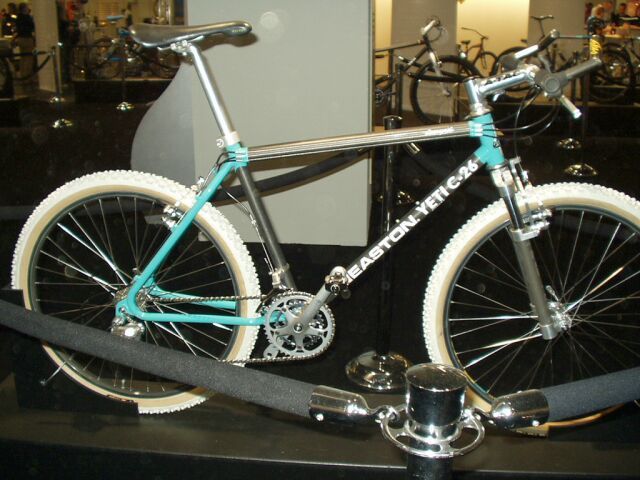
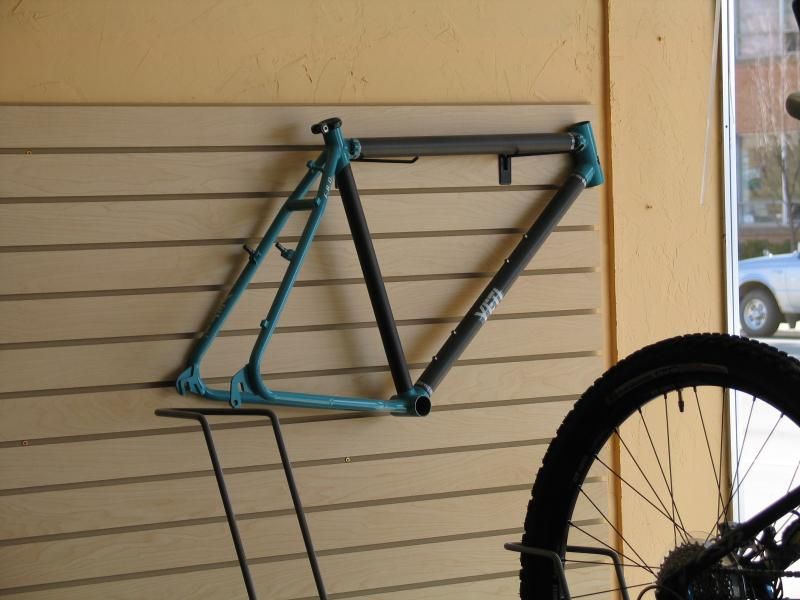
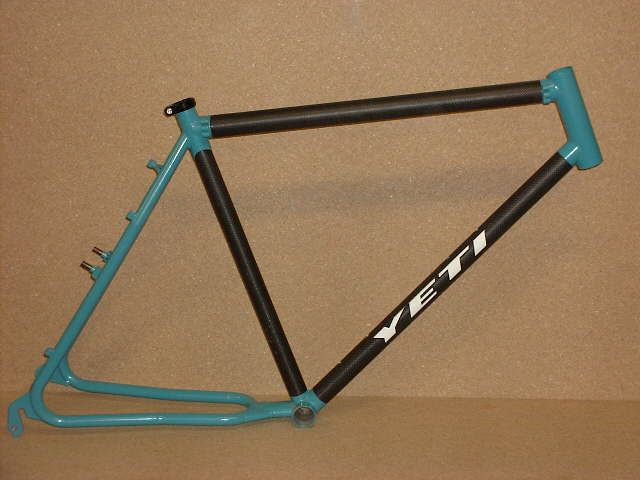
3rd Gen headbadge = Kit bike

This one gets ridden
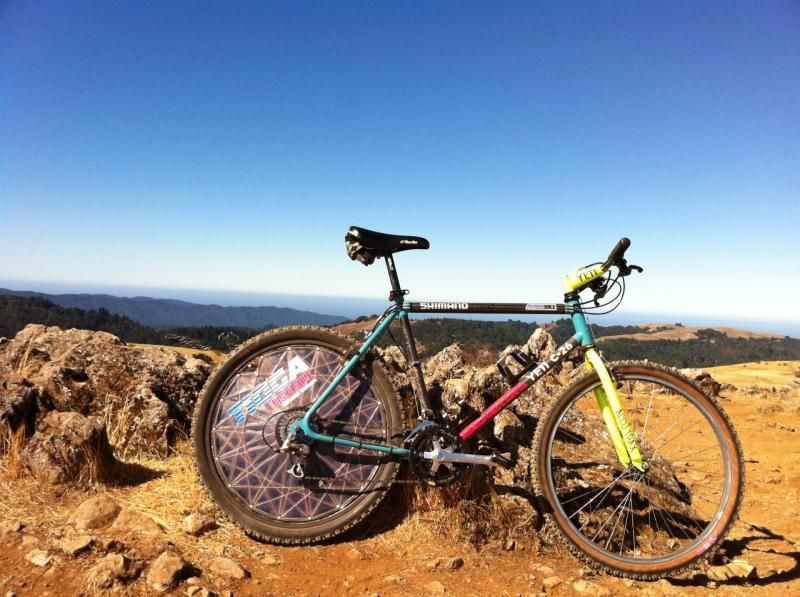
- The original bikes, including the prototype and team bikes. Also, according to Herting, one bike was made for a customer and never seen again
- The "kit" bikes. All bikes assembled after the project was scrapped using complete C-26 kits
- The rebirth "C-46" bikes made 2007-ongoing
Prototype / Team Frames
The prototype frame took 3 weeks to complete. This bike was previewed in May 1989 MBA and then tested in MBA in June 1989, photographed with Russ Worley riding it. Worley raced the bike for a few months, and then the bike was re-decaled and sent to the Interbike trade show in September. Worley says the frame broke at some point.
Construction outside the Agoura Hills factory




Previewed in the May 89 MBA. "Stronger than Chromoly!" Note the Answer decal on the downtube. This was the only bike made with Simplex dropouts and a the front derailleur operated by the chainstay cable anchor

The prototype and early team bikes featured cable stops glued onto the top tube instead of welded to the head and seattube junctions. This is the easiest way to ID the very early bikes. Also note the FTW stem clamped onto the nub welded into the steerer. A different stem than what was on the bike during the MBA test.

Race duty under Russ Worley. Black Bullseye cranks and red Easton decals

Photo shoot from the 1989 brochure

Different version of the brochure shot

Great shot of Worley in the June 1989 MBA Test

I'll try to put the entire MBA test scan together in order. Favorite quote: "B&W scan from the MBA feature. "The bonding process enables the frame to be taken apart, fixed, and reassembled if the tubes or lugs happen to break."
This would be reassuring on a 50mph fireroad descent. It also happens to be untrue.










C-26 and Treefrog. Given these bikes are all spiffed (and the FRO with Landshark paint), I'm thinking this is from the Interbike show. Note the custom Chuck Texiera Easton carbon seatpost. He used an SR Laprade head.

Another from the show?

This may be the finest living example of an early C-26. It was a team frame and likely one of Joey Erwin's. It has the top tube cable pads, but the newer style dropouts and the Bullseye derailleur pulley.

Another Joey Erwin frame. This was taken in May 1990 at the Georgia NORBA National. Erwin is standing next to the fan with everyone looking at his bike.

Likely the fate of this bike

In flite

This bike is a mystery to me. Herting traded it with Yeti Cycles for tooling. He says it's a team frame. The noticeable detail missing is the front derailleur pulley hole is missing, which is common with the kit bike frames. However, this is clearly not a kit bike as (1) it has no chainstay triangle fix and (2) it's obviously seen use. It hangs from the ceiling at Yeti. If anyone has any insight, let me know.


Juli Furtado race bike. My holy grail. This bike won a world championship and none other compares in terms of collectability and overall awesomeness. Sadly sold in John Parker ebay auction in 2002 for $6,800, which was amazing money back then. Completely custom made for her and finished days before the Durango World Championships in September, 1990. Famously converted from Campagnolo to Shimano the day before the race. On a warmup lap likely a day or two before.




MBA Inside the Pros Bikes article. Note many things were changed for the article including the stem and seatpost.
 John Tomac Frame #1. Given to him summer of 1990. Sold on ebay in 2009 for $12,500
John Tomac Frame #1. Given to him summer of 1990. Sold on ebay in 2009 for $12,500



John Tomac Frame #2 - Worlds XC Frame


Now residing in Switzerland with a confused build

John Tomac Frame #3. Worlds DH Bike.


I took this photo in 2008. Chris Herting had the bike shipped to him so he could "copy" it for the Tomac DB-1 limited run C-26 tribute bikes. Amazing to throw a leg over this piece of history.
 Given to Zapata Espinoza as a wedding present
Given to Zapata Espinoza as a wedding present

Tested in some UK Magazine. They trashed it in the mud. Incredible.

Chuck Texeira complete bike. Chuck was an Easton engineer and the man responsible for the collaboration with Yeti. Features the only other carbon Accutrax I know of other than mine.


Catalog bike? This was in the 1991 brochure. No idea where this ended up.

Kit Bikes
Various photos of kit bikes built after the move to Durango

Tomac replica

Riveted one

Yikes

Chris Herting personal frame

Wish I knew more about this one.



3rd Gen headbadge = Kit bike

This one gets ridden

Post 2008 Herting-Built Bikes
Mine
Tomac replica in the UK
French one
German one
Subscribe to:
Posts (Atom)

